If you’re thinking about adding a canine companion to your life, understanding dog breeds and their personalities is one of the best places to start. While every dog has its own unique quirks and habits, breed tendencies can tell you a lot about what to expect — from energy levels and social behaviours to trainability and space needs. Whether you’re living in a city apartment or have acreage in the country, choosing a breed that suits your lifestyle is key to a happy life for both you and your pup.
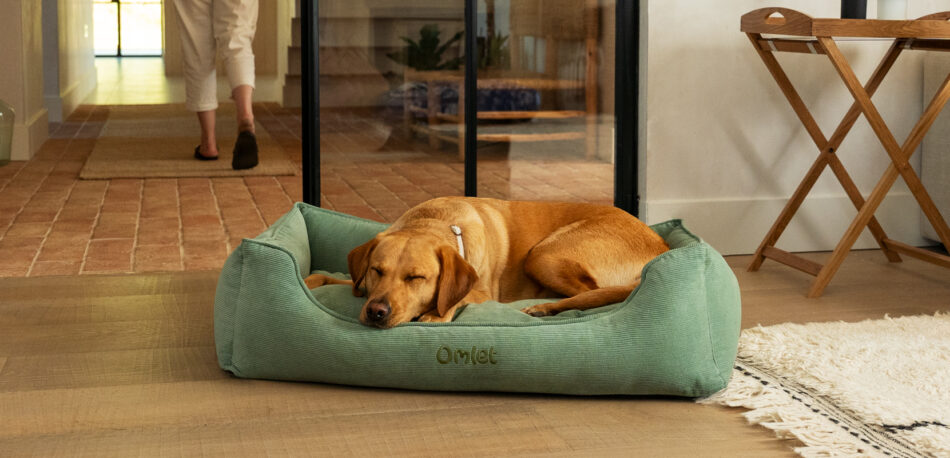
An overview of classic canine behaviours
Dogs have been domesticated and bred for centuries to perform specific tasks — retrieving, herding, guarding, or hunting to name a few — and each different breed often carries signature traits. Retrievers for example tend to be gentle and eager to please, while terriers are tenacious and quick, full of energy. Herding dogs are known for their intelligence and alertness, whereas companion breeds often thrive in closeness and affection.
That said, dogs are individuals. Just because a dog’s breed has been designed for a certain task for affinity doesn’t always mean they’ll live up to that standard. Training, environment, and early socialisation all play a vital role in shaping a dog’s personality. But if you know which dog breeds were developed to do, it will give you insight on better techniques and a good sense of the temperament you’re signing up for.
Get to know these popular breeds
Below is a snapshot of ten most common breeds or varieties of dogs, and which personality traits stand out. These insights can help you find a dog that fits your family and lifestyle — or better understand the dog you already love.
Labrador Retriever
Friendly, loyal, and intelligent, Labrador Retrievers are often called the “all-rounder” of the dog world. They’re well known for good with children and their trainability, making them a top choice for families or first-time dog owners. Labs have high energy levels, requiring adequate space and regular exercise along with mental stimulation to thrive. They love water, people, and pretty much everything life throws at them.
Dachshund
Bold, curious, and a bit stubborn, the Dachshund is a long-bodied dog with short legs. Their unique appearance is both comical and endearing, but don’t let their stature fool you — they’re brave hunters at heart, originally bred to track badgers. Dachshunds are independent thinkers that form strong bonds with their owners. They might not be keen on strangers, and often don’t appreciate being over-handled, so patient and gentle training is key.
Siberian Husky
If you’re looking for a dog with personality in spades, the Siberian Husky might be your match. These striking dogs are energetic, loyal, social, and often very vocal — howling, “talking”, and singing come naturally to them. Huskies are known for being clever, but also stubborn, and need consistent training with lots of exercise. Originally bred to pull dog sleds over long distances, these dogs don’t do well in small spaces, or when left alone for long periods of time.
Border Collie
Often considered the most intelligent dog breed, Border Collies are laser-focused, quick to learn, and happiest when they have a job to do. Originally bred for herding sheep, they love structure, routine, and mental challenges. They’re affectionate with their families but can be wary of strangers. Without enough mental and physical stimulation, Border Collies can become anxious or develop behavioural issues.
Small breeds
Small dogs pack big personalities. These dogs often thrive in attentive households and prefer life indoors. They don’t require much space, making them a good choice for apartment dwellers, or for smaller homes. Here are some small breeds and their typical personality traits:
- Chihuahua — Alert, loyal, and often fiercely devoted to one person.
- Pug — sweet natured, sociable, and love to be part of the action, but can’t tolerate much exercise due to their short noses.
- Pomeranian — perky, clever, and sometimes bossy, with a surprising amount of energy for their size.
- Yorkshire Terrier — small and spunky, these dogs have luscious locks that owners love to style.
Terriers
Terriers come in many shapes and sizes — Jack Russell, Cairn, Westies — but most share key traits: they’re spirited, confident, and full of drive. Originally bred to hunt vermin, terriers are persistent, vocal, and sometimes stubborn. They need consistent training and benefit from play that satisfies their hunting instincts (like digging or scent games). Terriers do best in homes where they’re mentally engaged and physically active.
Bulldogs
Most often seen in the English and French varieties, bulldogs are affectionate and often sensitive. English Bulldogs are known for their calm, gentle disposition and make great companions for quiet homes. French Bulldogs are a bit more spirited and playful, thriving on human interaction. Neither breed is suited to heavy exercise due to the shape and length of their snout, but both enjoy short walks and quality cuddle time.
Spaniels
Cavalier King Charles Spaniels, Cocker Spaniels, and Springer Spaniels are the most popular of this group, but spaniels come in many varieties. Spaniels are affectionate, intelligent, and very people-oriented. They’re eager to please and quick to learn, making them great for first-time owners. Spaniels love attention and thrive on praise, but don’t do well when left alone for long periods. Regular walks and grooming are a must for these dogs.
Golden Retriever
Similar in many ways to their cousin the Labrador Retriever, Golden Retrievers are gentle, intelligent, and eager to please. They’re excellent family pets and usually get along well with other animals. Goldens love to play and are always ready for a walk, fetch session, or swimming. Their mellow temperament makes them popular therapy or service dogs, but they’re probably best known for their gentleness with children.
Mixed breeds
Don’t overlook the magic of mixed breeds. These dogs can inherit traits from a variety of breeds and often have more balanced temperaments. Their personalities differ depending on their lineage, but many mixed breeds are adaptable, healthy, and deeply loyal due to their complex lineage.
How to choose the right dog for you
Selecting a dog isn’t all about looks or popularity — it’s about lifestyle, expectations, and what you want in a companion. Consider the following:
- Space: Do you live in an apartment or on acreage? Smaller, lower-energy breeds like Pugs or French Bulldogs are fit for compact homes, while Huskies and Collies thrive in open spaces.
- Activity level: Are you a runner or a homebody? High-energy breeds like Border Collies or Labradors need an active lifestyle, while English Bulldogs and Cavaliers are happier lounging.
- Time commitment: Dogs require time, but some need more than others. Working breeds and puppies require more hands-on attention, while older or lower-energy dogs may need less.
- Family and other pets: Some breeds are famously family-friendly (like retrievers and spaniels), while others may not be as tolerant of young children or other animals.
If you’re still undecided, consider volunteering at a shelter or fostering before adopting a dog to get to know their breed and individual personalities. Rescue organisations can also help match you with a dog that fits your lifestyle.
Personality-based dog care basics
Once you’ve chosen your dog, their care will depend in part on their personality and breed traits:
- Exercise: High-energy dogs need daily walks, playtime, and mental challenges. Lower-energy dogs may be content with a stroll and some snuggles.
- Feeding: Diet should match your dog’s size, age, and activity level. Ask your veterinarian about a diet that’s most suitable for your dog.
- Training: Intelligent or strong-willed breeds benefit from early, consistent training and socialisation. Positive reinforcement is a good dog training tactic for all breeds but is especially important for more sensitive canines.
- Grooming: Long-haired dogs require regular trips to the groomer, and should be brushed routinely. All dogs should have their nails trimmed routinely to prevent them from growing too long.
- Veterinary care: Dental cleanings, spaying and neutering, and vaccinations are all essential to your dog’s health — and all done through a veterinarian. Choose your dog’s veterinarian early on (even before bringing your dog home) and take them for their first visit shortly after bringing them home.
No matter the breed, dogs need structure, affection, and consistency to thrive.
Omlet and your dog
At Omlet, we believe every dog deserves a life as unique as their personality. That’s why we create innovative, thoughtful dog products designed to keep pups happy, healthy, and close to the people who love them. Explore our stylish dog crates, ideal for creating safe, comforting spaces in your home. And, our cozy dog beds come in a range of sizes and colors to match every breed and every decor. Whatever breed you bring home, we’re here to help you give them the best life possible.
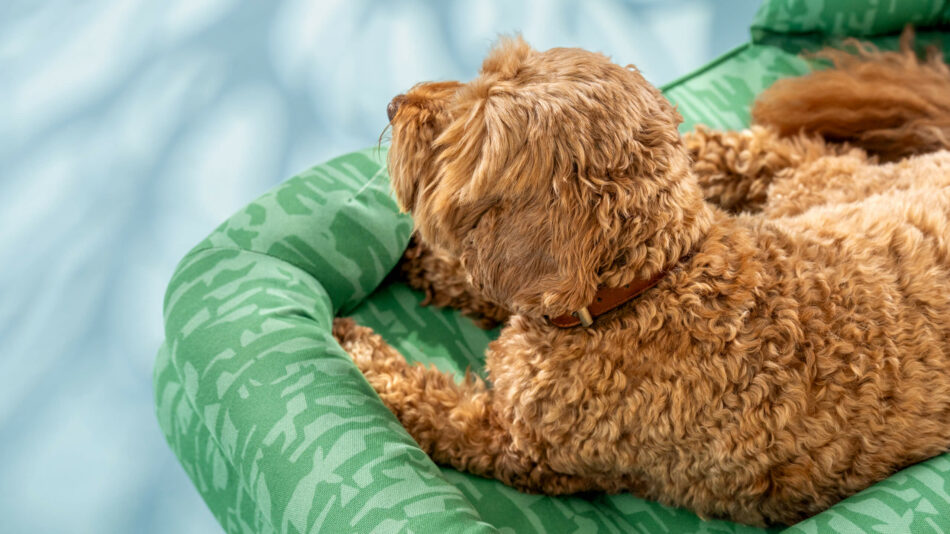

This entry was posted in Dogs
It’s the year 2025 — of course we’ve all become our dogs’ personal butlers. From homemade treats to pet store dog toy sprees, we would do anything for our pups. Do we spoil our dogs? Probably. Does it matter? Probably not. But for those of us taking stock, here are 20 signs of a pampered pooch.
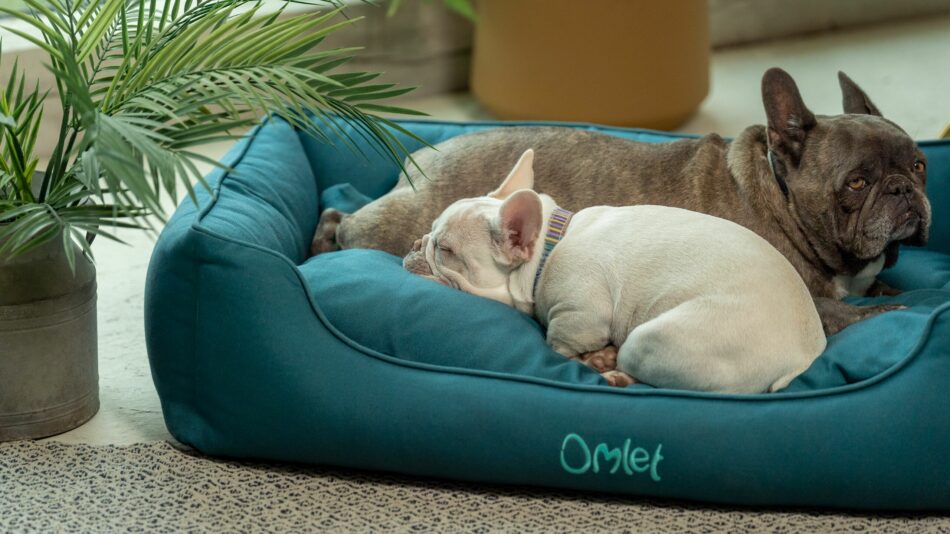
20 tell-tale signs that you’re spoiling your dog
Dogs appreciate a good spoiling, and as long as it doesn’t jeopardize their health and wellbeing — why not? We all indulge our dogs’ deepest (or even fleeting) desires, but there are some signs that your doggie-devotion is over-the-top. Think you’re in this “extra” category? Here are the signs.
Open your pantry to find nothing but pup treats? The good news: that means you’re rationing your dog’s intake — bravo! The bad news: now you have to go to the store for human-fare.
Pet store shopping sprees
Taking your dog to the pet store is one thing. It’s another thing entirely to line up an assortment of toys to let them pick one (or 5) out to bring home.
If you buy a new sprinkler for your backyard just because your dog enjoys them — and not because your grass needs watering — your dog might have you wrapped around their little paw.
With novelty shapes, character themes, and tantalizing textiles, who can’t resist a new dog toy? It’s really more for you than for them anyway…
You look forward to your dog’s spa days as much as your own. Now that’s devotion.
Your dog’s treats are all organic, sustainably sourced, and packed with vitamins and minerals — while yours are decidedly not.
Your afternoon of DIY projects has disappeared, dedicated instead to doling out belly rubs, playing fetch, and going for a walk to say hello to the park ducks.
The freezer is full of yummy offerings — for your dog. No ice cream or popsicles for humans are to be found.
You’ve spent two hours in the kitchens baking up the latest canine culinary creations for your dog and their closest friends. Looks like it’s store-bought cupcakes for your kids’ next event.
Your dog might not physically boot you from your favourite spot, but their adorable appearance curled up in your chair is enough to send you in search of another seat.
The show currently on the TV isn’t for you — it’s for your dog. That’s ok, you can use the time to catch up on your crochet project, which is of course a sweater for your pup.
You spend as much time and effort purchasing and hiding your dogs’ presents as you do your human family members.
When you have a lull during your business trip, you call to check-in with the dog sitter — which may coincidentally be your significant other or best friend — and the first thing you ask is “How’s the dog?”
You’re a master at doggie-massage and homeopathic remedies, but rely heavily on coffee and a prayer for your own self-care.
Planning dinner? Of course you’ve already thought about your canine companion eating first so you can both sit and enjoy the latest dog documentary.
Your dog’s yearly salon expenses are more than your own.
You know all of the restaurants that allow pups on the patio, and make a list of dog-friendly dining options for every town you visit.
Your dog’s “room” under the stairs was planned and decorated with more care than your own bedroom.
Like a true best friend, you don’t want to offload your drama onto your dog because you don’t want them to worry. But since your dog is your best friend, they listen with rapt attention — and won’t be the least bit bothered by any embellishments.
Dog-friendly destinations
You’ve taken yet another trip that catered to canines. But it’s hard to find a better travel buddy when your dog is up for any adventure.
Omlet and your dog
The moral of the story is that as long as it doesn’t result in overeating, over-stressing, or over-exercising, does it really count as spoiling? Your dog won’t feel spoiled by these acts of devotion — only loved. Top off your pooch’s preferential treatment with dreamy dog beds, comfortable canine crates, and other dog products that show them just how much they mean to you.
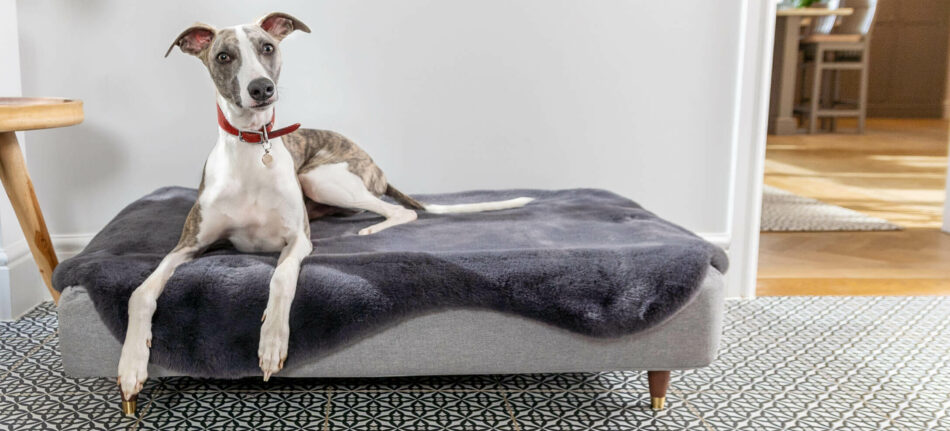

This entry was posted in Dogs
Researching everything you need for a happy and healthy dog? You’re in good company. Dogs are the most popular pets all around the world, with an average of one-third of households globally containing at least one canine. There’s a reason why they’re called man’s best friend, but how can we be sure they’re getting everything they need from us? Here’s a guide to what dogs need to live long, happy lives, and how to spot a dog that isn’t thriving in their environment.

Every dog should have its day — every day
Dogs are well known for radiating positivity and love. But to foster this eternal optimism, we have to ensure our dogs’ basic needs are met. While there are a multitude of ways to accomplish this, here are the basics of canine care:
- Safe, supportive, and sanitary living conditions with a comfortable dog bed or dog crate, a lead and collar or harness for walks, and items to clean up after them.
- Quality food and fresh water served in easy-to-clean dog bowls.
- Exercise and enrichment in the form of quality time spent with you, a variety of toys, and time spent training basic commands and tasks.
- Routine veterinary care and checkups to receive necessary vaccinations and maintain overall and long-term health.
When all of these needs are fulfilled, dogs are able to live long, happy lives — bringing us joy and companionship that is unique to the canine species. Here’s an in-depth look at how to practically provide your dog with their basic needs.
Conditions fit for a canine
Dogs deserve a supportive environment — in fact, it’s essential to their well-being. Most dogs thrive best inside with their owners, and should have their own designated spaces for eating and sleeping. Feed your dog in the same place each time they’re fed, and place their dog bed in a common area for them to catch a nap where the rest of your family relaxes. Orthopedic, comfy dog beds support growing puppies and aging dogs alike, giving them the deep, relaxing sleep they need for their overall health.
With some exceptions, many dogs find comfort in having a dog crate. Dogs are den animals by nature, and they like having a space that they can call their own. In addition to appealing to your dog’s nature, dog crates also provide a safe, practical space for dogs to stay in while their owners are away from home. And, since dogs don’t like to go to the bathroom where they sleep, crates can be a valuable potty training tool.
Other tips for making your home more dog-friendly include:
- Keeping noise levels down, as dogs have much keener hearing than we do.
- Laundering their dog bed cover routinely to keep it fresh.
- Make sure visitors know about your dog and can follow your guidelines for safe interaction.
Your dog’s diet
We may think that eating the same food every meal would be boring, but for your dog, this routine keeps their digestion and overall health in order. Dogs should be exclusively fed quality food formulated for their size and age range. Some dogs can be offered treats as a reward during training sessions, but treats should always be given sparingly to prevent your pup from becoming overweight or experiencing digestive upset.
Choose a dog food that doesn’t contain too many fillers like corn, and make sure it’s an appropriate formulation for your dog. Puppies need puppy food to receive adequate nutrition for their growth, while mature dogs need a different ratio of nutrients to support a healthy weight and joint health. Large breeds need additional nutrients that support their bones and joints that regular or small breed dog food may be lacking in.
Your veterinarian will be able to help you make the best dietary decisions based on your dog’s age, size, and overall health needs. And remember, if you’re switching up your dog’s food, do so slowly over the course of 2 weeks to avoid upsetting your pup’s stomach. Feed your dog according to their waistline — not the recommendations on the bag — and wash their bowls weekly to prevent bacteria from building up. Always have fresh water readily available, kept out of direct sunlight and in the same location for your dog to find easily.
Attention, training, and quality time
One of the best things about having a dog is that you have a companion that’s ready for adventure at a moment’s notice. Most dogs are thrilled at the prospect of a walk, playtime, or even just a quick pat on the head in passing. It’s part of what makes dogs such amazing pets.
But as much as we enjoy time with our dogs, most dogs crave time with us. It’s important to give ample attention to your dog, and provide them with plenty of outlets to expel their energy. Some dog breeds and individual dogs are more high strung than others, requiring a “job” or additional training to keep their active minds engaged.
Aim to spend a set amount of time each day with your dog. This could be in the form of a walk, a training session, or playtime. Time spent with your canine companion not only strengthens your bond, but also gives your dog a sense of purpose and belonging. Even just 15-30 minutes a day spent interacting with your dog will go a long way in keeping their minds sharp and energy expelled.
Veterinary care
Shots are no fun — but getting sick is a lot worse. It’s important that puppies complete all of the recommended rounds of vaccinations, usually 3-4 sets spaced out in 3-4 week intervals. Don’t take your puppy to public places where dogs frequent, like the dog park or pet stores, until they are fully vaccinated.
Regular checkups are important throughout your dog’s life. These visits should occur at least once or twice a year depending on your dog’s age and overall health. Spaying or neutering your dog is recommended starting at 6 months of age, but large breed dogs may benefit from delaying this procedure by a few months to help their musculoskeletal development. Your veterinarian may recommend bloodwork to make sure your dog is aging gracefully, or a dental cleaning to keep their oral health on track.
Like human health, our dog’s health is a journey. Follow your veterinarian’s guidelines, and work to keep your dog at a healthy weight to prevent health conditions from developing. Plenty of exercise, a good diet, routine vet visits, and a loving home are a winning combination to a happy, healthy dog.
How can I tell if my dog is happy and healthy?
Subtly isn’t a trademark of the canine species. Dogs wear their positive emotions on their metaphorical sleeves, and a happy dog is a sight to behold. Here are the signs of a happy, healthy dog:
- Shiny coat, and bright, clear eyes
- Wagging tail, and alert expression when spoken to
- Their ribs can be felt with soft palpation, but not seen, and they have a defined waistline
- They move evenly and surely on all four legs
- Their water and food intake is consistent
- Regular potty breaks with formed stool that’s easy to pick up
- No noticeable breathing sounds (with the exception of brachycephalic breeds like Bulldogs, Pugs or Boston Terriers)
- They seem at ease in their surroundings, without displaying nervous behaviours like shaking, hiding, or tucking their tail
- No deviations in normal personality or behaviour
Some dogs are naturally more reserved than others, and some pups may prefer a quiet movie night with you over a game of fetch. What’s important is consistency in your dog’s demeanour and appearance.
Here are some signs that your dog is not happy, or may be experiencing issues with their health:
- Dull or flaky hair coat
- Shaking their head repeatedly, especially with smelly or red ears
- Tucked tail, or hunched back
- Skittish behaviour, or constantly hiding
- Decreased appetite
- Vomiting or loose stool
- Inappropriate or increased urination, especially with increased drinking
- Noticeable sounds when breathing
- Limping, difficulty standing, or trembling legs
- Obsessively licking paws or forelegs
- Increased vocalisations, particularly in response to sounds
- Nipping or other behavioural issues
If you notice any changes in your dog, or are concerned about their behaviour, contact your veterinarian. Some changes may have a simple solution such as missing nutrients or minor environmental changes.
Omlet and your dog
Dogs share a remarkable bond with humans that spans centuries. That’s why we create remarkable dog beds, dog crates, and dog accessories that celebrate our unique relationship with these canine companions. Long live happy, healthy dogs.
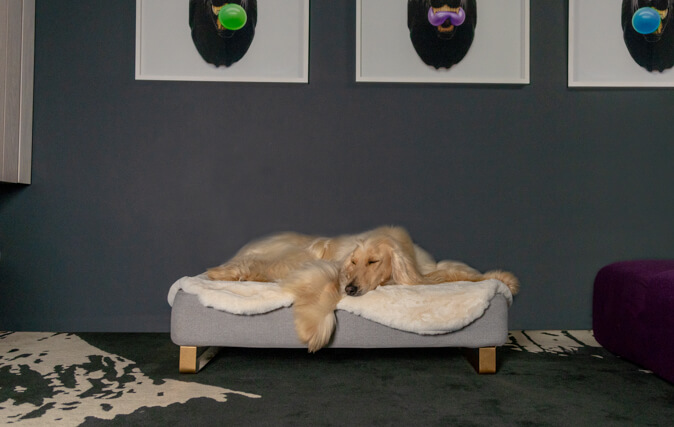

This entry was posted in Dogs
As the mercury rises, it’s essential to consider not just our own comfort but also the well-being of our furry friends. Dogs, with their fur coats and limited ability to cool themselves, can struggle in hot weather. Understanding how to care for your dog during the summer months is crucial to ensure they remain happy and healthy. This guide will explore how to keep your dog comfortable in the heat, recognize when it’s too hot, and offer tips on cooling them down.
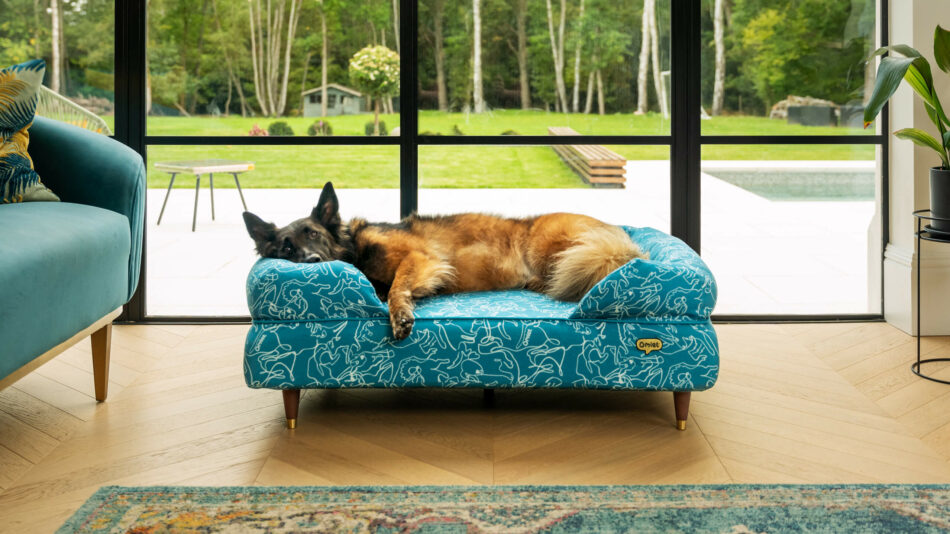
How to know if it’s too hot for fido?
When the summer sun is blazing, it’s crucial to ensure your furry friend stays safe and comfortable. One of the best ways to determine if it’s too hot for fido is by feeling the pavement with your own bare feet. If the surface is too hot for you to stand on for more than a few seconds, it’s definitely too hot for your dog’s sensitive paws.
Know the signs of overheating
Remember, dogs regulate their body temperature differently than humans and can quickly overheat, leading to dangerous health issues like heatstroke. So pay close attention to your pet’s behaviours and look out for these signs;
- Excessive panting
- Drooling
- Lethargy
- Anxiety
- General discomfort
These are all red flags that it’s time to get them indoors and cooled down immediately.
Another critical indicator is the ambient temperature and humidity levels. Dogs are more susceptible to heat stress when the temperature exceeds 85°F (30°C), especially if they have a thick coat or are a flat-nose breed like bulldogs or pugs. Ensuring your dog has access to shade, fresh water, and avoiding walks during peak heat hours are essential precautions. Additionally, consider their activity level—playful pups might not realize they’re overheating. By taking these steps, you can ensure Fido stays happy and healthy, ready to enjoy the summer by your side without the risk of heat-related ailments.
What to do with your dog when it’s hot
During hot weather, modifying your dog’s routine is essential to prevent overheating. Start by ensuring they have access to plenty of fresh, cool water at all times, and avoid taking them out during the peak heat of the day. Instead, opt for early morning or late evening walks when the pavement is cooler and the sun less intense.
Consider investing in a dog cooling mat or vest, which can provide significant relief from the heat. If your dog enjoys water, a kiddie pool in the shade can be a fun and effective way to help them stay cool while getting some exercise.
Another great way to beat the heat is by creating a cool indoor haven for your furry friend. Keep the blinds drawn and the fans or air conditioning on to maintain a comfortable temperature. Engage your dog with indoor activities, such as interactive dog toys and brain games, to keep them mentally stimulated without overheating. Homemade frozen treats, like ice cubes with embedded dog-safe fruits, can be a delightful way to cool down.
Remember, if your dog shows signs of overheating, such as excessive panting, drooling, or lethargy, it’s important to act quickly and consult a veterinarian. Keeping your dog cool during hot weather is essential for their health and happiness, and with a little creativity, you can ensure they stay safe and comfortable all summer long.
What to do if your dog is too hot
Preventative measures are crucial to avoid overheating in the first place. So when summer temps rise, avoid strenuous activity during the hottest parts of the day and provide ample shade and water. And never leave your dog in a parked car. But if your dog still shows signs of overheating, it’s critical to act quickly.
- Move them to a cooler environment immediately.
- Offer fresh, cool water to drink but avoid forcing them to drink if they aren’t interested.
- Apply cool (not cold) water to their body, focusing on the paws, belly, and neck to help lower their temperature gradually.
- Monitor your dog’s temperature and watch for signs of improvement or worsening.
Having read this guide you will be equipped to manage your pooch if they’re too hot, however, in cases where symptoms are severe, seek veterinary attention immediately. Heatstroke can escalate quickly and can be fatal if not treated promptly. While waiting for veterinary help, you can help cool your dog by wetting their coat with cool (not cold) water and using fans to increase evaporation. Avoid using ice-cold water or ice packs directly, as this can cause the blood vessels to constrict and reduce the cooling effect.
Omlet and your dog
At Omlet, we understand that every dog is unique and requires special care, especially in extreme weather conditions. That’s why we ask the right questions to tailor our products to meet the needs of all dogs, no matter the temperature. Our innovative solutions, from dog cooling mats to designer dog beds for much needed rest, are designed to ensure your dog stays comfortable and safe. With Omlet, you and your dog can enjoy each other’s company to the fullest, even during the hottest days of the year.


This entry was posted in Dogs
Summer is a time of adventure and fun for both humans and their canine companions. However, the sweltering heat and unique challenges of the season can pose risks to our furry friends. As responsible pet owners, it’s crucial to ensure our dogs remain safe, healthy, and comfortable during the hottest months of the year. Here are six essential summer safety tips to keep your dog cool, hydrated, and protected.

Keep your dog cool
As pet owners, your primary concern during summer is preventing your dog from overheating. But unlike humans, dogs don’t sweat. Instead, they rely on panting and releasing heat through their paws and nose to cool down. So in order to help them stay cool this summer, try to limit outdoor play to dawn and dusk hours to avoid peak heat and temperatures. And when you are in the great outdoors, be sure to always provide your pup access to shady spots.
One of the best ways to keep your canine cool this summer is by creating a cool retreat at home with fans or air conditioning. You can also use dog cooling mats or vests specifically designed for dogs. Frozen treats and ice cubes can also be a fun and refreshing way for your dog to cool off. Just place some frozen homemade treats in their dog bowl after an evening walk to enjoy as they cool down.
Adjust walk times and avoid hot pavement
Taking your dog for walks is essential, but during summer, the timing and surface can make a big difference. When the temperatures rise, pavement and asphalt can become dangerously hot, potentially causing burns to your dog’s sensitive paw pads. So how do you know if it’s too hot to take your dog on a walk?
Before putting your dog’s favourite collar and lead on, first test the pavement with the back of your hand; if it’s too hot for you to touch for more than a few seconds, it’s too hot for your dog. Instead, opt for early morning or late evening walks when temperatures are lower. If walking on hot surfaces is unavoidable, consider protective booties for your dog’s paws or stick to grassy, shaded areas.
Keep your dog hydrated
Ensuring your dog stays hydrated during the summer months is crucial for their health and well-being. As temperatures rise, dogs can quickly become dehydrated, which can lead to serious health issues like heatstroke. To keep your furry friend hydrated, always provide fresh, cool water in their dog bowls and carry a portable water bowl or a water bottle with a built-in dispenser during walks or outings. During summer it’s important to pay attention to signs of dehydration, such as excessive panting, dry gums, or lethargy. If you notice any of these symptoms, offer water immediately and move your dog to a cooler area.
To make hydration more appealing, you can also incorporate hydrating treats into your dog’s diet. Freeze chicken broth or water mixed with a bit of low-sodium beef broth into ice cube trays for a refreshing, hydrating snack. You can also offer fruits like watermelon, which is not only hydrating but also a favourite treat for many dogs. And during playtime, opt for water-based activities like sprinklers, lakes, or the pool, providing both fun and hydration. Just be sure to monitor them when in open bodies of water and make sure they are rinsed off with clean water after all swim activities.
Schedule a vet appointment
Just like humans, dogs are susceptible to heat-related illnesses such as heatstroke and dehydration. By scheduling a vet visit early in the season, you can get ahead of any potential health issues and receive professional advice tailored to your pet’s specific needs. Your vet can check for any underlying conditions that might be exacerbated by the heat, update vaccinations, and even offer tips on keeping your furry friend cool and comfortable during the hottest months. It’s also an excellent opportunity to discuss the best flea and tick prevention strategies, as these pests thrive in warmer weather.
Before the vet checkup, make a list of questions about summer care, like how much water your dog should be drinking or the best times for walks to avoid peak heat. Additionally, consider scheduling the appointment during the cooler parts of the day, like early morning or late evening, to make the trip less stressful for your pet. And don’t forget to bring along a favourite toy or treat to keep them calm and comfortable during the visit. Taking these steps not only prepares you for a productive vet visit but also demonstrates your dedication to your dog’s health and happiness throughout the summer.
Watch out for insect bites
Mosquitoes, ticks, and fleas are more active during the warmer months and can cause discomfort or even health issues for your dog. Regularly check your dog’s coat and skin, especially after walks in wooded or grassy areas. Pay close attention to areas like the ears, belly, and between the toes where ticks often hide. A quick daily inspection can help you spot and remove ticks before they latch on. Remember, it’s not just about looking for insects; also watch for signs of bites, such as excessive scratching, redness, or swelling.
To protect your dog, consider using vet-approved insect repellents and preventatives. There are various options, including topical treatments, collars, and oral medications, so you can choose what works best for your dog’s lifestyle and needs. Keep your yard well-maintained by mowing the lawn regularly and removing any standing water, which can be breeding grounds for mosquitoes. Additionally, washing your dog’s bedding frequently can help minimize the risk of flea infestations. The Topology dog bed designed by Omlet offers easy to remove and wash covers, making it a great bed choice for your dog every month of the year.
Safe travelling in the car
Summer often means road trips and vacations, and bringing your dog along can be a lot of fun. However, it’s important to ensure they stay comfortable and safe during car rides. First and foremost, always ensure your dog is properly secured in the car, either with a pet seat belt or in a dog crate. This not only keeps them safe but also prevents distractions while driving.
Remember to never leave your dog alone in a parked car. In summer, temperatures can rise to dangerous levels in just minutes, even with the windows cracked. Regularly stopping for water breaks and allowing your dog to stretch their legs will help keep them hydrated and comfortable during the journey. To ensure your dog’s comfort in the car during summer travels consider easy travel dog beds, this could be cushion beds or nest beds that are lightweight and fit into the back of the car and can be transferred to a preferred spot with ease.
Omlet and your dog
At Omlet, we understand that your dog’s safety and happiness are paramount, especially during the summer months. Our team of pet enthusiasts and experts designs products with a deep understanding of what dogs need to thrive in any weather. From innovative dog crates to travel dog bed solutions, Omlet’s range of products is crafted to keep your pup safe and comfortable, no matter the temperature outside. Trust us to provide the best for your furry family members, ensuring both of you enjoy a fantastic, worry-free summer.
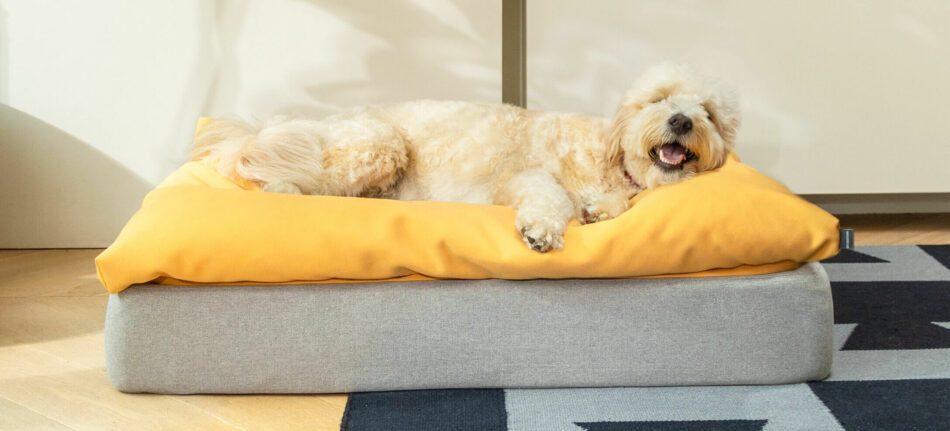

This entry was posted in Dogs
A happy dog is a healthy dog, and as pet parents, we all want to provide the best for our canine companions. Dogs thrive when their physical and mental needs are met, and just like humans, they benefit from a comfortable environment, engaging activities, and plenty of love. In this guide, we’ll dive into everything your dog needs to stay happy, from the importance of enrichment and staying active to creating a cozy sleeping space.
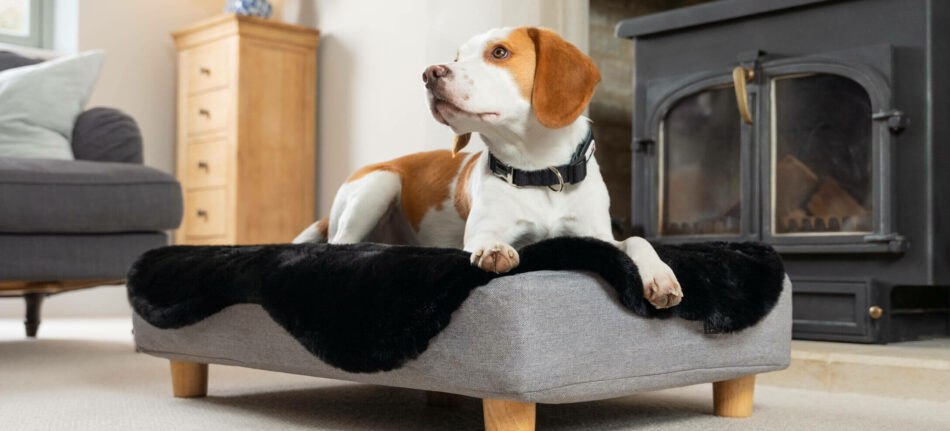
Why is enrichment important for dogs?
Enrichment is a key component of your dog’s overall well-being. Much like us, dogs can get bored when they don’t have enough to do, and that boredom can lead to anxiety, destructive behaviours, or even depression. Simply put, enrichment is any activity or object that stimulates your dog’s mind and body, helping them engage in their natural behaviours like sniffing, chewing, and playing.
For example, giving your dog a new chew toy or a Kong filled with treats encourages them to problem-solve and keeps them entertained for hours. Enrichment is not just about keeping your dog busy—it’s about providing them with opportunities to express their instincts in a healthy and satisfying way.
Health, love, and care tips for your dog
Caring for your dog goes beyond feeding and walks. To ensure your dog stays happy and healthy, you have to care for the entire well-being of your dog from mental to physical and everything in between.
Health check-ups: Routine vet visits are essential for your dog’s long-term health. Even if your dog seems perfectly fine, these check-ups can catch potential health issues before they become serious. Your vet will check everything from dental health to joint movement, ensuring your dog is in peak condition. Keeping up with vaccinations, flea treatments, and heartworm prevention is just as important, even during the winter months when you might not think about parasites as often.
Balanced diet: A well-balanced diet is the foundation of your dog’s health. Consult with your vet to ensure you’re feeding your dog the right mix of nutrients, based on their age, size, and activity level. And don’t forget, how you feed them can also be an enriching experience. Slow feeders or treat-dispensing toys can make mealtime more stimulating and help prevent overeating.
Daily love and attention: Dogs are social animals and thrive on companionship. Make sure to set aside time every day for quality interactions, whether it’s playtime, snuggling on the couch, or a walk around the neighbourhood. Your presence, affection, and attention are just as important to their happiness as any toy or treat.
How to give your dog the best
Your dog deserves the best in comfort, health, and enrichment. So here are a few tips to ensure your dog stays happy, healthy, and well-rested:
- A cozy, supportive dog bed
Your dog needs a bed that’s not only comfortable but also supportive for their joints, especially if they’re getting older. Omlet’s Topology dog beds offer superior comfort, easy cleaning, and stylish designs that fit seamlessly into your home. Whether your dog loves to curl up or stretch out, there’s a bed that’s just right for them.
- Keep bedding fresh and clean
Maintaining clean bedding is essential for your dog’s health. So choose a bed with a removable, machine-washable cover to ensure your dog’s sleeping space is always fresh and hygienic. A clean bed means fewer allergens, better sleep, and a healthier environment for your furry friend.
- Keep them active with enrichment toys
Dogs need both mental and physical stimulation to stay happy. Enrichment toys like food puzzles, chew toys, and interactive games provide your dog with hours of entertainment, helping them burn off energy and stay mentally sharp.
- Winter gear for outdoor adventures
For dogs that love the cold, make sure they have the right winter gear. A warm dog coat and booties can make all the difference when braving the elements. Keeping them comfortable ensures they can enjoy their time outdoors, even in colder months.
Omlet and your dog
At Omlet, we believe the key to creating products that truly enhance the lives of both pets and their owners starts with understanding the unique bond you share. By asking the right questions—what does your dog really need for comfort, health, and happiness?—we’ve designed products that celebrate the connection between you and your furry friend. From our supportive dog beds to enriching toys and practical solutions, our mission is to create items that make you both happier and healthier.
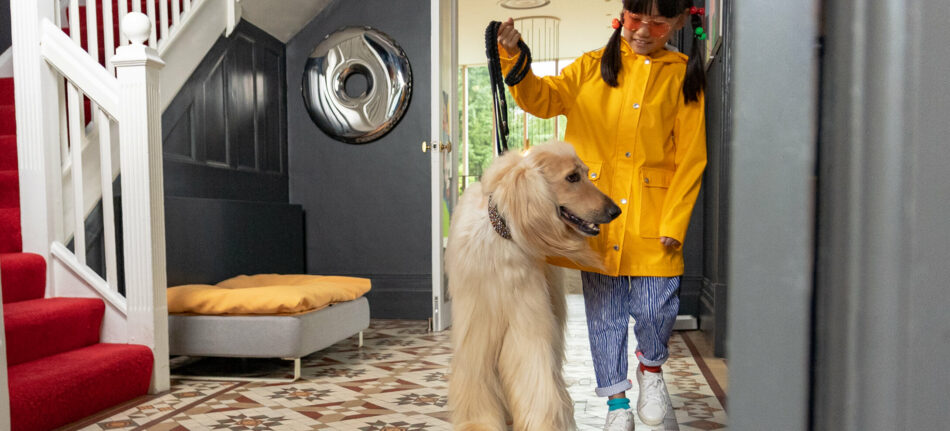

This entry was posted in Dogs
Our dogs are more than just pets; they’re family members, confidants, and companions who show us unconditional love every single day. But how do you know if your dog loves you back? Dogs may not express their feelings in words, but their actions speak volumes. Understanding the signs of your dog’s affection can deepen the bond you share and make your relationship even more special. So, let’s take a look at 10 ways you know your dog loves you.
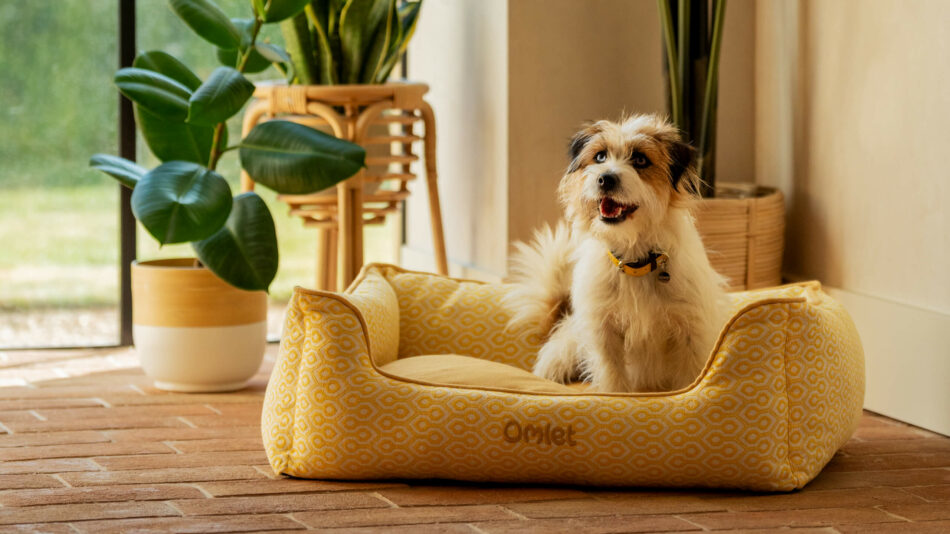
The wagging tail
One of the most obvious signs of a dog’s love is a wagging tail. But it’s not just any tail wag that counts; a dog’s tail can communicate a lot of different emotions. A wagging tail that is loose and sweeping back and forth, sometimes even in a circular motion, is a sure sign that your dog is happy to see you and is feeling affectionate. You may see this behaviour exhibited most often when you arrive home after work, grab their dog lead and collar for a walk, or just when you re-enter a room where they haven’t seen you for 5 minutes.
Following you everywhere
Does your dog follow you from room to room, even to the bathroom? This shadow-like behaviour is actually a sign of deep attachment and love. Dogs are pack animals by nature, and following you around is their way of appointing you as their “pack leader.” It’s their way of showing that they feel safe and secure in your presence and that they enjoy being close to you at all times. So place their dog bed next to yours or put a cosy dog blanket on the couch and spend some extra time giving and receiving that affection with your furry friend.
Bringing you their favourite toys
When your dog brings you their favourite dog toy, it’s not just a request for playtime—it’s also a sign of love and trust. Just like people, dogs will often share their prized possessions as a way of showing that they value you. Not only is your dog trying to include you in their fun, but they want to make you happy. So the next time your pup brings you their favourite toy, get down and play with them to let them know you receive their love and give it right back as well.
Leaning against you
Has your dog ever just sat on your feet when you’re standing in the kitchen or leaned up against you as you watched TV? This means they love you. When your dog leans against you, it’s a physical way of saying, “I trust you, and I feel safe with you.” This gesture, whether they’re resting their head on your lap or leaning their whole body against you, is a clear sign of affection. Your dog is seeking closeness and comfort from you, which indicates a strong bond of love and trust.
Making eye contact
Dogs don’t naturally make eye contact with just anyone—it’s a behaviour that’s usually reserved for those they trust and love. So when your dog gazes into your eyes with soft, relaxed eyes, it’s a sign of their deep connection with you. Prolonged eye contact actually releases oxytocin (the love hormone) in both you and your dog, reinforcing your bond. So the next time you see your furry friend staring your way, stop and engage in the stare – you will show them how much you love them in return.
Licking you
Did you know dogs can kiss? While they may do it differently than humans, licking is often seen as a dog’s way of giving you a kiss. Most people associate a dog’s licking to be a sign of submission or grooming. However, when your dog licks your face or hands, it’s often an affectionate gesture. Just as mother dogs groom their pups out of love, your dog’s licking is a way of showing that they care about you and want to keep you clean and healthy.
Cuddling with you
Dogs are naturally pack animals, and cuddling is a way that they reinforce bonds with their family. In the wild, dogs would create a ‘den’ made of leaves and brush to cuddle with one another for sleep and comfort. So if your dog loves to snuggle up next to you, whether it’s on the couch or in bed, it’s a clear sign that they feel comfortable and safe with you. This close physical contact is a way for your dog to show that they love you and want to be near you. So to show your love in return, try adding their favourite dog blanket to the couch or creating the perfect dog bed den next to your bed so they can feel close to you all the time.
Greeting you excitedly
Is your dog always thrilled to see you when you come home, even if you’ve only been gone for a short time? This excited greeting is a sign that your dog loves you and misses you when you’re not around. Your dog may show this excitement through fast movement of the tail-up wagging, jumping in place or on you, or even with an excited bark. Regardless of what they do to show their excitement, you can know that the fact that they are greeting you this way is a sure sign that they love you.
Bringing you “gifts”
Sometimes, dogs show their love by bringing you “gifts”—like sticks, leaves, or even things they find around the house. While these gifts may not always be something you want, it’s the thought that counts. By bringing you these items, your dog is showing that they care about you and want to share their findings with you. So the next time your dog’s favourite toy shows up in your shoes, know that it is a gesture of love.
Sleeping near you
Dogs are vulnerable when they sleep, so if your dog likes to sleep near you or even in your bed, it’s a sign of deep trust and love. They feel safe and secure in your presence and want to be close to you even when they’re at their most relaxed. This is one of the ultimate signs that your dog loves you and considers you a part of their pack. Invest in a durable and long-lasting, comfortable dog bed so you can show your dog just how much you love them too.
Omlet and your dog
At Omlet, we understand that the bond between pets and their people is something truly special. That’s why we design products that celebrate this connection and make it even stronger. Whether it’s a cosy dog bed for them to sleep next to you or a soft, cuddly dog blanket that you can share together on the couch, Omlet’s thoughtfully designed products are made to enhance the love you share with your furry friend. Because at the end of the day, our pets aren’t just animals—they’re family.


This entry was posted in Dogs
As dog lovers, we often find ourselves marvelling at the quirky, lovable behaviours of our furry friends. From their enthusiastic tail wags to their mysterious grass-eating habits, dogs never fail to keep us guessing. Whether you’re a seasoned pet parent or a new dog owner, you’ve probably wondered about some of the peculiar things dogs do. In this blog, we’ll dive into ten commonly asked questions about dogs, shedding light on why they do what they do and helping you better understand your four-legged companion.

Why do dogs love to fetch?
Dogs’ love for fetching can be traced back to their ancestry. Many dog breeds were originally bred for hunting and retrieving game. Fetching a ball or a stick mimics this natural hunting behaviour, giving dogs a sense of purpose and fulfilment. Additionally, fetch provides physical exercise and mental stimulation, both of which are essential for a dog’s well-being. The excitement of the chase, the thrill of catching the object, and the joy of returning it to their owner create a rewarding cycle that most dogs find irresistible.
Why do dogs pant?
Panting is a crucial way for dogs to regulate their body temperature. Unlike humans, dogs do not sweat through their skin. Instead, they have sweat glands in their paw pads and rely heavily on panting to cool down. When a dog pants, it evaporates moisture from its tongue, nasal passages, and the lining of its lungs, helping to dissipate heat. Panting can also indicate stress, pain, or excitement, so it’s important to observe the context in which your dog is panting to understand what they might be feeling.
Why do dogs wag their tails?
A wagging tail is often seen as a sign of a happy dog, but a flap of fur can convey a range of emotions. Dogs use their tails as a communication tool. The speed, height, and direction of the wag can indicate different feelings. A broad, sweeping wag usually means happiness and friendliness, while a slow, stiff wag might signal caution or insecurity. Understanding the nuances of tail wagging helps us better interpret our dogs’ emotions and respond appropriately to their needs.
Why do dogs love walks?
Walks are a highlight of most dogs’ days for several reasons. Firstly, walks provide physical exercise, which is vital for maintaining a healthy weight and overall fitness. Secondly, walks offer mental stimulation as dogs encounter new sights, sounds, and smells. This sensory input is incredibly enriching for dogs, helping to keep their minds sharp. Walks also serve as a bonding activity, strengthening the relationship between dogs and their owners. The routine and predictability of daily walks can provide comfort and a sense of security for dogs. So, grab your dog’s favourite collar and lead and make walking the best part of your day together.
Why do dogs have wet noses?
A dog’s wet nose is more than just a sweet spot to give them a kiss. A wet dog nose enhances their sense of smell. The moisture helps to absorb scent chemicals, making it easier for them to detect and analyze different smells. And did you know a wet dog nose can aid in regulating a dog’s body temperature? The mucus glands inside the nose produce a watery fluid that, through evaporation, helps cool them down. While a dry nose isn’t always a cause for concern, a consistently dry nose can sometimes indicate dehydration or other health issues, so it’s good to monitor any changes in your dog’s nose moisture.
Why do dogs scoot their bottoms on the ground?
Scooting is often a sign that a dog is experiencing discomfort or irritation around their anal area. This behaviour can be caused by a variety of issues, including anal gland problems, parasites, allergies, or even infections. If you notice your dog scooting frequently, it’s important to have them checked by a veterinarian to determine the underlying cause and receive appropriate treatment. Regular grooming and a healthy diet can also help prevent some of the common causes of scooting.
Why do dogs lick?
Licking is a natural behaviour for dogs and can serve multiple purposes. It can be a way for dogs to show affection, as licking releases pleasurable endorphins that make them feel good. Dogs also lick to communicate, groom themselves, and explore their environment. Sometimes, excessive licking can indicate anxiety, boredom, or a health issue, so it’s important to observe the context and frequency of your dog’s licking to determine if there might be an underlying problem.
Why do dogs howl?
Howling is an ancient form of communication that dogs inherited from their wolf ancestors. Dogs howl to alert their pack to their location, ward off intruders, or express anxiety and loneliness. In modern times, dogs might howl in response to certain sounds, like sirens or music, or to get attention from their owners. Understanding the reason behind your dog’s howling can help you address any potential issues, such as separation anxiety or boredom, that might be causing this behaviour.
Why do dogs stare?
When your dog stares at you, it’s usually a sign of affection and trust. Dogs use eye contact as a way to communicate with their owners, seeking attention, guidance, or even just to bond. Staring can also be a sign that your dog is trying to understand your emotions and intentions. Dogs are highly attuned to their owners’ body language and facial expressions, and maintaining eye contact can help them feel more connected and secure.
Why do dogs eat grass?
There are several theories about why dogs eat grass. Some suggest that it helps with digestion, while others believe dogs eat grass to induce vomiting when they feel unwell. Eating grass might also be a way for dogs to get additional nutrients or fiber in their diet. Generally speaking, occasional grass eating is considered normal behavior. However, if your dog is eating large amounts of grass or showing signs of gastrointestinal distress, it’s best to consult with your veterinarian.
Omlet and your dog
Understanding our dogs’ behaviours and needs is key to ensuring they lead happy, healthy lives. At Omlet, we are dedicated to making life with your dog as enjoyable and fulfilling as possible. Our ingenious products such as our easy-to-clean dog beds and luxury dog crates are designed to cater to every aspect of your dog’s life, from their physical health to their emotional well-being. By addressing common questions and providing innovative solutions, Omlet helps you spend more quality time with your furry friend. Discover how Omlet can enhance your bond with your dog and make every moment together even more special.
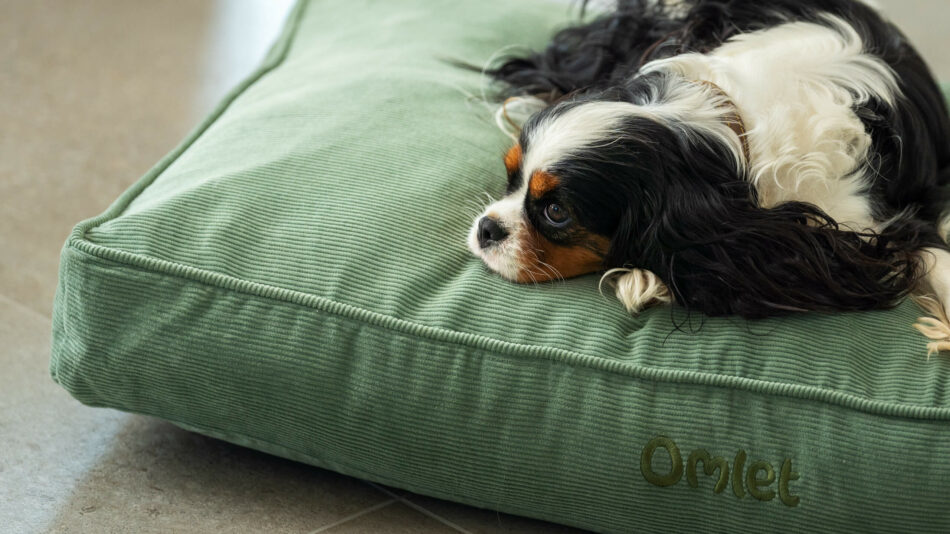

This entry was posted in Dogs
Imagine this: your beloved dog, a picture of playful vitality, suddenly starts scratching incessantly, develops red, watery eyes, or suffers from persistent sneezing fits. These could be signs of common dog allergies, an often overlooked but significant issue affecting our furry friends. In this blog, we’ll delve into the world of canine allergies, uncovering the triggers, symptoms, and treatments that can help you restore your dog’s comfort and happiness. Whether it’s seasonal pollen, certain foods, or unexpected environmental factors, understanding and addressing these allergies is crucial for the well-being of your loyal companion.
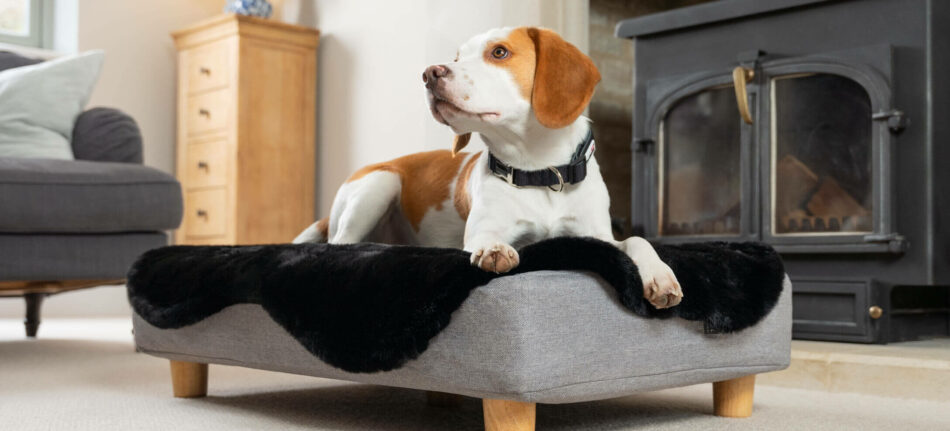
Can dogs get allergies?
Yes, dogs can get allergies, just like humans. But what exactly is an allergy in dogs? An allergy is simply an overreaction of the immune system to a typically harmless substance, known as an allergen. When the body encounters an allergen, it mistakenly identifies it as a threat and produces antibodies to fight it off. This immune response results in various symptoms that can range from mild to severe.
Canine allergies manifest when a dog’s immune system reacts to specific substances in their environment, food, or other factors. These allergic reactions can cause significant discomfort and health issues for our furry friends. So recognizing the signs and types of allergies in dogs is essential for managing their well-being effectively.
Symptoms of dog allergies
Dog allergies can present in various ways, often making them challenging to diagnose. Here are some common symptoms to watch for:
- Itchy skin: This is the most notable and common of all dog allergy symptoms. Manifesting through frequent scratching, licking, or biting at the skin, itchy skin can often lead to redness and irritation.
- Skin rashes and hives: While similar to regular itchy skin, rashes and hives present more as red, inflamed patches on the skin. Typically these are a result of exposure to a specific allergen.
- Chronic ear infections: Does your dog shake its head or itch their ears often? This could be as a result of an ear infection. Recurring ear issues are often associated with discharge and odour and are often directly related to some type of allergic reaction.
- Runny nose and watery eyes: Just like humans, dogs who suffer from allergies often have runny noses and watery eyes. The clear discharge from the nose and excessive tearing is usually as a result of inhaling an allergen or sniffing too close to one.
- Paw chewing/licking: Itchiness from allergies is not selective just to the skin – it can impact a dog’s paws, too. If you notice your dog persistently licking or chewing at their paws, they could very well be experiencing allergies.
- Digestive issues: Symptoms such as vomiting, diarrhea, or other gastrointestinal problems are often directly related to a food allergy. Pay close attention to your dog’s reactions and notice if these digestive issues appear right after eating. If so, they likely have a food allergy.
- Behavioural changes: Humans with allergies know all too well how uncomfortable these symptoms can be. The same is true for dogs. Increased irritability, restlessness, or lethargy are all common changes in behaviour for dogs who suffer from allergies.
Recognizing these symptoms early can help you seek appropriate treatment for your dog’s allergies and prevent further complications.
Types of dog allergies
Dogs can suffer from several types of allergies, each with its own set of triggers and symptoms. Understanding the type of allergy affecting your dog is crucial for effective management and treatment. Here are some of the main types of dog allergies:
- Food allergies: While food allergies are the least common of canine allergies, they can still cause severe issues. Reactions to specific ingredients in their diet, such as beef, chicken, dairy, or grains, can lead to digestive problems, skin irritations or other allergic symptoms.
- Environmental allergies: Sensitivities to pollen, mould, dust mites, and other airborne allergens are some of the most common causes of canine allergies. While most dogs are impacted seasonally, indoor allergens can cause year-round allergies as well.
- Skin allergies: If you’ve noticed any hot spots or bald patches on your dog, they are likely suffering some type of skin allergy. Often caused by flea bites or other direct contact, your dog will itch with such frequency it will result in flea allergy dermatitis.
- Contact allergies: Did you know dogs can be allergic to certain shampoos, fabrics or cleaning products just like humans? If you notice your dog itching a lot after coming in contact with a new product, refrain from using it to be sure you don’t cause any continued allergic reactions.
Breeds more susceptible to allergies
Certain dog breeds are more prone to allergies due to their genetic predispositions and body makeup. Breeds like golden retrievers, bulldogs, pugs, boxers, and terriers are all dogs that are particularly susceptible to allergies. Factors such as breed-specific skin characteristics, immune system variations, and common hereditary conditions contribute to their increased risk of developing allergies.
For instance, bulldogs and pugs have more skin folds, which can trap allergens and moisture, leading to skin infections and allergic reactions. Whereas golden retrievers and boxers often have genetic predispositions to food and environmental allergies. Knowing your dog’s breed-specific risks can not only help you take preventive measures but also allow you to seek early intervention from your vet when needed.
Creating an allergy-free zone at home
Maintaining an allergy-free environment is paramount for dogs suffering from allergies. This involves regular cleaning of their spaces to reduce allergens such as dust mites, pollen, and mould. Does your dog sleep in your room or find a sanctuary in their dog den? Using air purifiers near these spaces and keeping windows closed during high pollen seasons can help alleviate the allergens. Frequent bathing with hypoallergenic shampoos can also help minimize skin irritation and remove allergens from your dog’s coat.
Omlet’s line of dog beds can be an invaluable addition to your allergy management toolkit. Ingenious designs such as the Topology dog bed and Cushion dog bed come with easy-to-remove, machine-washable covers that help keep allergies at bay. Additionally, Omlet offers elevated dog beds that keep your dog off the floor, reducing their exposure to dust and other allergens commonly found on the ground. By incorporating Omlet’s dog beds into your home, you can create a cleaner, more comfortable space for your allergy-prone pet.
Omlet and your dog
At Omlet, we understand the unique needs of dogs and strive to design products that enhance their well-being and comfort. Our commitment to quality and innovation is driven by our desire to make life with your pet as joyful and hassle-free as possible. Whether it’s providing easy-to-clean dog beds or safe haven dog dens, Omlet is dedicated to improving the bond between you and your furry friend. Explore our range of products today and discover how we can help you and your dog live a healthier, happier life together.


This entry was posted in Dogs
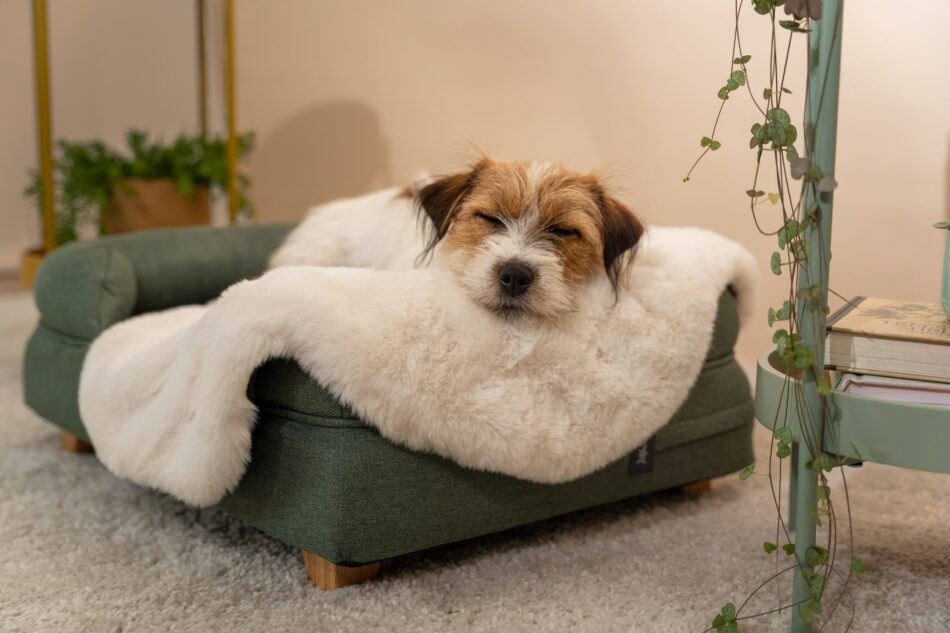
The leaves are falling and temperatures are dropping. Autumn has faded into winter and the crisp air hints at colder weather to come. As you move into winter with a cosy jacket, help your pooch conquer the cold and welcome in the new season by your side. Follow these tips for transitioning your dog into winter and watch them wag their tail goodbye to crunchy leaves and hello to snow-filled strolls.
How cold is too cold?
Most dogs can tolerate cold temperatures pretty well – they do have a built-in fur coat, after all. But how do you know when winter cold is too much for Fido? The best way to temperature check your dog is by looking out for these signs:
- Sitting in a hunched position with their tail tucked in.
- Whining incessantly – this is usually dog speak for “I’m cold – let’s go get warm”.
- Reluctant to go on a walk when they usually love being outside.
These breeds were made for winter
All dogs need some extra care and warmth during the winter months but certain breeds are more susceptible to becoming too cold. Those most likely to need the help of a winter coat are the smaller, short-haired breeds like beagles, pugs, and chihuahuas. Hardier dog breeds such as Siberian huskies and malamutes, on the other hand, fare much better in cooler climates.
Don’t be fooled by their size – there are a few larger dog breeds that struggle in the winter, too. Great Danes, Salukis and German shorthaired pointers are a few examples that are more averse to chilly temperatures due to their shorter coats or minimal body fat.
You’ll want to pay close attention to your dog’s body language on cooler days. Temperatures of 45℉ or below can become risky for long walks or extended outdoor play for dogs susceptible to getting too cold, including older dogs as well.
Winter entertainment essentials
Cold-weather walks around the block may suffice in some parts of the country for dogs this winter, but when the temperatures start to plummet too low, it’s time to move the exercise indoors.
Keeping your dog stimulated indoors is important all year round but especially when conditions mean daily walkies might be off-limits. Here are a few ways to keep your dog active indoors when it’s too cold to play outside:
- Toys, toys, and toys. Whether plush or hard, squeaky or silent, dog toys are an excellent way to keep your dog’s playtime going when indoors. Plus, a game of tug of war or indoor fetch are great bonding activities for you and your pet.
- Hide and see the treats. One of the best ways to get your dog moving is to have them hunt for hidden treats throughout the house. This game doubles as brain training too, so your pup will be able to get both a physical and mental workout in.
- Have a playdate. When it’s too cold to meet up at your favourite dog park, consider having a dog friend over instead to burn off some energy.
- Training and tricks. Take advantage of the extra time with your furry friend by teaching them a new trick. Keep sessions short and be sure to use plenty of treats and praise to get Fido motivated.
Creating your dog’s winter wonderland
To make sure your dog stays snug this season, create a winter wonderland inside by cosying up your quarters. Winterproofing your home for your dog has never been so easy with Omlet’s range of ingeniously designed products to take you through the year.
Nothing’s better than coming home to a warm bed after being outside on a winter’s day. And with Omlet’s Topology Dog Bed not only will you provide your pup with an unparalleled sleep experience on a supportive memory foam mattress, but you can customize their topper from a variety of options that keep them warm and cosy all winter long. Simply zip on a new topper when it’s time to get comfy and zip it off to clean those muddy paw prints with a quick spin in the machine.
Choose from the Sheepskin topper for the ultimate snuggly soft sleep, or for post-snowy walkies, the Microfibre topper is quick drying to get them feeling warm again in no time.
To take their bed to another level of comfort, layer up with the Omlet Luxury Faux Sheepskin Dog Blanket. Or place the plush throw on your bed or couch so you can share a snuggle together. Plus, with three sizes to choose from, you can choose a blanket big enough to wrap around any dog.
Should your dog’s diet change in winter?
While humans may sometimes gain an extra layer of warmth during the holiday seasons, be careful your dog doesn’t follow suit. Just like us, dogs may try and consume more calories during winter to try and create an extra layer of warmth. But, overconsumption of food can lead to health complications in the long run if not watched carefully.
If your dog is active the rest of the year but they start to slow down during winter, you’ll want to maintain a steady calorie intake to not add too much weight. Speak to your veterinarian about switching their diet away from foods high in carbohydrates and more protein and fibre-rich foods to keep them fuller longer.
An extra helping of omega-3 will also be beneficial for your pup this season. This will help with keeping their skin and coat in top condition, free from flaking and itching. Your veterinarian will be able to tell you what they think is best for your pet, but dog-friendly omega-3 supplements are readily available online or in your local pet store.
Omlet and your dog’s winter
Winter can be one of the best seasons, especially with your dog by your side. While you might be spending more time on the couch and less time out on adventures, with products like the Topology Dog Bed and Luxury Faux Sheepskin Dog Blanket from Omlet, transitioning into this wonderful time of year has never been easier.
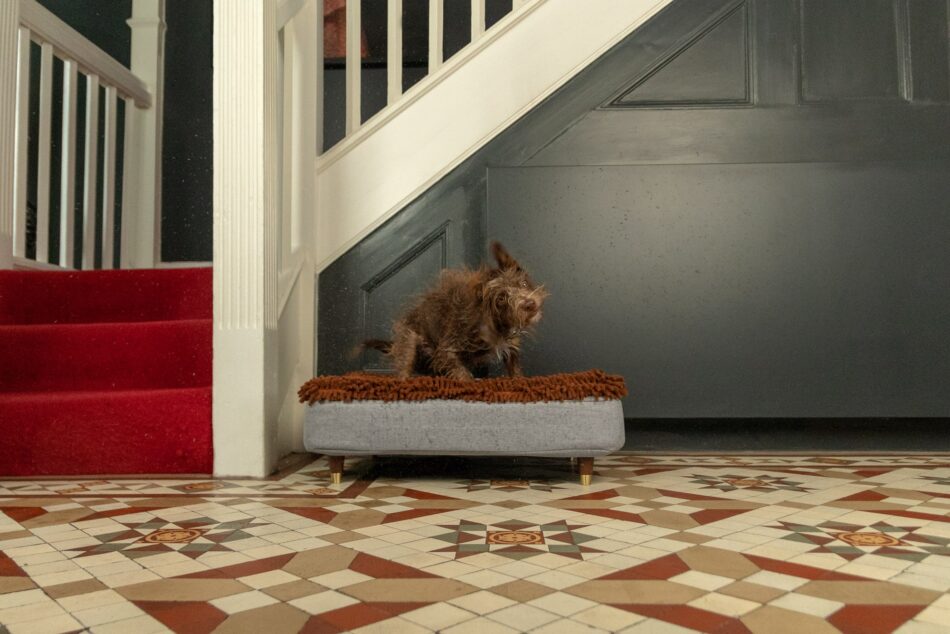

This entry was posted in Dogs
Bringing home a puppy is one of the most exciting moments in a dog lover’s life. But the first few months with a puppy can also be a whirlwind of joy, chaos, and learning. From endless puppy cuddles to the not-so-glamorous potty training, these early days are full of surprises. Join us as we explore what to expect, tips for success, and how Omlet products can help you and your puppy have a smooth start.

What you need to know about puppies
They have endless energy
Puppies are a bundle of energy that can keep you on your toes. If you’re expecting a little ball of fur to lie at your feet all day, you might be surprised by their boundless enthusiasm. Puppies need a lot of exercise, and without it, they can become restless and destructive. So in the first few months with your new puppy you’ll want to prepare for frequent walks, playtime, and interactive dog toys to help them burn off energy.
Teething pains are real
Teething is a challenging phase for both puppies and their owners. As their teeth come in, puppies experience discomfort and will chew on anything to relieve the pain. This stage can last for several months, and it’s essential to have appropriate chew toys and teething solutions on hand to prevent them from destroying furniture, shoes, or other valuable items. A durable dog bed will also be in order to ensure your puppy’s sleeping quarters don’t become their chewing station.
Socialisation is crucial
One key aspect of raising a puppy is socialisation. During the first few months, puppies are more open to new experiences and people. This is the prime time to introduce them to a variety of environments, people, and other animals to ensure they grow up to be well-adjusted adults. Without proper socialization, they might develop fear-based behaviours or aggression. Just be sure to always consult first with your vet to make sure your new pup is up to date on necessary vaccinations and is allowed to be around other dogs
Training should start early
Training is another critical component of a puppy’s early development. The sooner you start, the easier it will be to teach them good behaviour and basic commands. Early training not only helps with obedience but also strengthens the bond between you and your puppy. Consider starting with simple commands like sit, stay, and come. Consistency is key, so make training sessions short and fun.
Puppy love
One of the best parts of having a puppy is the sheer cuteness they bring into your life. Those big puppy eyes, tiny paws, and playful antics can melt anyone’s heart. You’ll find yourself taking endless photos and videos to capture every adorable moment. Puppies have a way of making even the most mundane activities feel special.
And it’s likely that cuteness overload that creates such a strong initial bond between you and your new pup. As you care for them, play with them, and train them, you’ll develop a unique connection that grows stronger over time. Puppies are incredibly loyal and affectionate, and the first few months are the perfect opportunity to create a lasting relationship.
Things to avoid to prevent bad habits
One of the biggest mistakes new puppy owners make is inconsistent training. If you’re not consistent with commands, rules, and rewards, your puppy will become confused and struggle to learn. It’s essential to establish a routine early on and stick to it. Avoid mixed signals and ensure everyone in your household follows the same guidelines.
And because these small bundles of fur are so cute, it’s easy to let things slide. However, improper puppy training can lead to problems down the road that will be harder to correct as an adult dog. Allowing bad behaviours like jumping on people, nipping, or chewing on inappropriate items can become ingrained habits. Nip these behaviours in the bud by redirecting their energy and providing positive reinforcement for good behaviour.
Puppy products to the rescue
Omlet offers a range of products designed to make the first few months with a puppy as smooth as possible. These items can help with training, comfort, and keeping your puppy entertained. Here’s a look at some of our top products:
Topology Dog Bed: Let’s face it, puppies have lots of accidents – it’s part of their process. So you need a bed that’s easy to clean and handle the wear. That’s where the Topology dog bed comes on. This dog bed features easy-to-wash covers, making cleanup a breeze when your puppy has accidents or gets dirty. And the covers are so durable that even sharp puppy teeth are no match.
Fido Nook Dog House: Being a puppy is a tough job. Everything is new and the first few months can feel overwhelming. That’s why having a secluded safe spot for your puppy to retreat to is essential for their well-being and development. The Fido Nook Dog House is a comfortable and stylish crate that’s perfect for training and providing a safe space for your puppy and give them their own space in adult life. Bonus – it will double as a piece of modern furniture in your home.
Omlet Dog Blankets: One of the best ways to offer your puppy comfort and calm is with a soft, snuggly blanket. The Omlet dog blankets offer coziness and warmth for your puppy, whether they’re snuggling in their crate or lounging on the sofa. Try wrapping the dog blanket around you before placing it in your puppy’s crate so they have a familiar scent to help soothe them when you are away.
Omlet and your dog
Omlet understands that raising a puppy is both rewarding and challenging. That’s why we’re dedicated to creating products that make owning a puppy as enjoyable and stress-free as possible. By focusing on what makes the relationship between people and pets special, Omlet continues to design innovative solutions that support you and your puppy, from those first few months, through their senior years. With products such as our easy-to-clean dog beds, dog blankets and dog crates, coupled with a little patience, you’ll find that having a puppy is one of the most delightful experiences you could wish for.
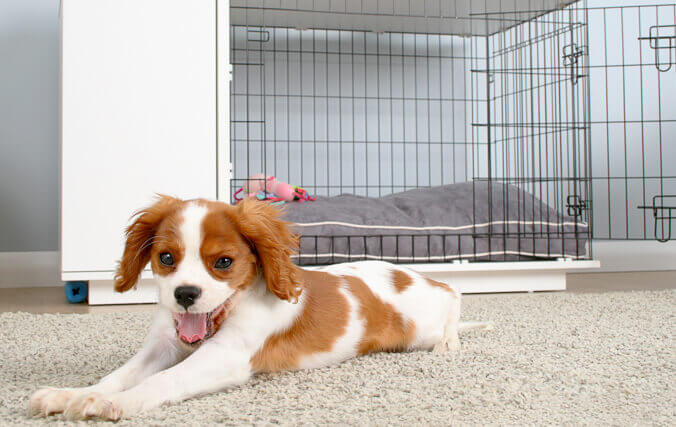

This entry was posted in Dogs
Training your dog can sometimes feel like you’re navigating through a maze without a map. However, with the right approach and understanding, it can transform into an enriching experience for both you and your canine companion. Whether you’re teaching basic commands or refining behavioural issues, these top seven dog training tips will set you on the path to success. From puppies to seniors, these tips are universally applicable, fostering a strong bond between you and your beloved pet.
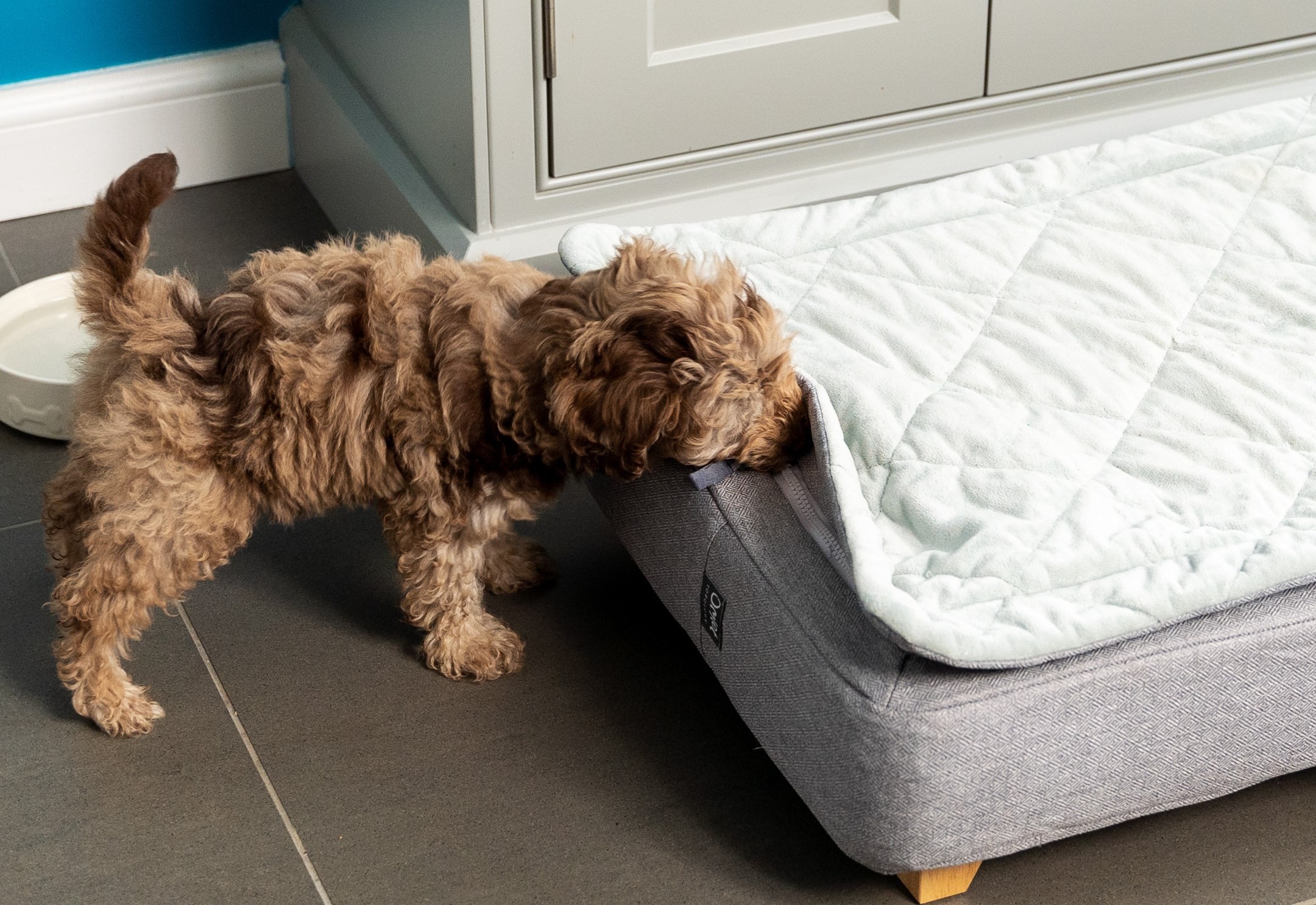
Consistency is key
Consistency is the cornerstone of effective dog training, much like the steady rhythm of a heartbeat. Dogs thrive on routine and predictability, and it’s through consistent actions and expectations that they learn best. So whether you’re teaching basic commands like sit and stay or more complex behaviours, such as walking on a dog lead without pulling, maintaining a consistent approach is paramount.
To achieve consistency in dog training, consider establishing a set schedule for training sessions. Just like how we mark our calendars for important events, setting aside dedicated time each day for training reinforces the routine for both you and your pup. Additionally, use consistent verbal cues and hand signals for commands, ensuring clarity in communication. Dogs are brilliant at picking up patterns, so sticking to the same cues for desired behaviours helps solidify their understanding.
Moreover, consistency extends beyond formal training sessions—it’s about applying the rules consistently in all interactions. Whether it’s not allowing your dog on the couch or insisting on sitting before meals, enforcing these boundaries consistently reinforces the desired behaviour. Think of it as setting the stage for your dog’s success by creating a reliable framework within which they can thrive and learn.
Positive reinforcement
Positive reinforcement is the gold standard in modern dog training. With this essential component, it’s all about highlighting the good stuff – the behaviours you want to see more of – with rewards that make your dog’s tail wag with delight. Think of it as a canine high-five for a job well done. So, when your furry friend nails that perfect sit or finally masters the art of fetch without chasing squirrels halfway across the park, whip out their favourite dog treats and shower them with praise.
However, in a recent interview with Kieren Beckles, co-founder and editor of helloBARK! And LifeWithKleeKai, he described how food and treats don’t always work as motivators for all dogs. Speaking about his two Alaskan Klee Kai dogs, Kieran said, “We had different experiences training Copper and Skye. Skye isn’t food motivated so it required a lot of repetition and positive reinforcement. Copper is food motivated but easily distracted so we used treats and repetition.”
So positive reinforcement is not just about the treats. Sure, those tasty morsels work wonders, but it’s also about showering your pup with praise, scratches behind the ears, and maybe even a goofy victory dance. Dogs thrive on love and attention, and when they associate good behaviour with all these good vibes, they’re bound to repeat it. When it comes to positive reinforcement, precision and timing are key. So make sure to dish out those rewards pronto, right when your dog performs the desired behaviour.
Patience pays off
Patience is not just a virtue; it’s the secret sauce in successful dog training. Much like us humans, our furry companions need time to understand, learn, and adapt to new behaviours. Rushing the process often leads to frustration for both the trainer and the pup. So when it comes to dog training, take a deep breath, and embrace the power of patience. As Kieran from helloBARK! says, “training is a way to connect to them (dogs) on a deeper level and understand their individual needs.”
It’s easy to get frustrated when your dog doesn’t grasp a command right away, but patience and persistence are your best allies. Break down each training task into manageable steps, rewarding incremental progress. Remember, Rome wasn’t built in a day, and neither are well-trained dogs. So celebrate small victories along the way. Whether it takes a few weeks or a few months, trust that your patience will pay off in the form of a well-behaved and happy dog by your side.
Clear communication
Effective communication is vital in any relationship, including the one you share with your dog. Dogs rely on body language, tone of voice, and verbal cues to interpret commands and expectations. So when you’re doing any type of training with your dog, use clear and concise commands, accompanied by corresponding gestures or signals. And keep your body language open and inviting to convey confidence and authority without intimidation.
For instance, when teaching your pup to sit, pair the verbal cue “sit” with a hand signal—a raised palm works wonders. Consistency is key; ensure everyone interacting with your dog uses the same cues and signals to avoid confusion. Remember, dogs don’t understand human language but can pick up on tone and body language effortlessly, so by keeping your signals clear and your demeanour positive you will better engage them in the training.
Mental stimulation
When it comes to dog training, mental stimulation is just as important as physical exercise. Much like humans, dogs need mental challenges to keep their minds sharp and engaged. Incorporating mental stimulation into your training routine not only prevents boredom but also strengthens the bond between you and your furry friend. Try incorporating puzzle toys or interactive dog toy games into your training regimen. These not only provide mental stimulation but also give your pup a chance to problem-solve and work out their cognitive muscles.
Another effective way to provide mental stimulation is through scent work. Dogs have an incredible sense of smell, and tapping into this natural ability can provide hours of entertainment. Hide dog treats around the house or in the backyard and encourage your dog to sniff them out. This not only engages their mind but also taps into their instinctual behaviours. By incorporating mental stimulation into your dog’s training routine, you’ll not only keep them mentally sharp but also strengthen your bond and have a happier, more well-rounded pup.
Socialization
Socialization plays a pivotal role in dog training, much like how meeting new people broadens our horizons. Dogs thrive on interaction and exposure to various environments, sounds, and stimuli from an early age. So introducing your furry friend to a spectrum of experiences in a positive and controlled manner lays the groundwork for a well-adjusted and confident companion. Whether it’s a bustling city street or a tranquil park, each encounter shapes your dog’s understanding of the world, fostering adaptability and reducing anxiety in unfamiliar situations.
Ideally you want to start socializing your pup when they are around three to fourteen weeks old, which is when they’re most receptive to new experiences. But no matter what age your dog is, keep all new interactions positive by pairing new encounters with treats, praise, and gentle encouragement. Kieran from helloBARK! advises, “While new dog owners might consider basic commands such as sit, lie down, stay and heel which are all important, I would encourage owners to do research about the dog they’re adopting, whether it’s purebred, mix or a rescue. Think outside the box!” It’s all about building positive associations and turning potentially scary situations into delightful discoveries.
Seek professional help when needed
Embarking on the journey of dog training can be both rewarding and challenging. Sometimes, despite our best efforts, our dogs may exhibit behaviours that leave us scratching our heads. This is where seeking professional dog training help can make all the difference. Whether it’s mastering basic commands or addressing more complex behavioural issues, a skilled trainer can provide guidance tailored to your pup’s needs. Don’t be hesitant to reach out for assistance; after all, even the most experienced dog owners can benefit from a fresh perspective.
When selecting a professional trainer, consider their qualifications and methods. Look for certifications or memberships in reputable organizations, as these indicate a commitment to ongoing education and ethical training practices. Additionally, inquire about their approach to training. Positive reinforcement techniques, which reward desired behaviours, are widely regarded as the most effective in any dog training. Remember, the goal is to build trust and cooperation, fostering a strong relationship built on mutual respect.
Omlet and your dog
At Omlet, we understand the profound connection between pet parents and their dogs. That’s why we’re dedicated to creating innovative products that enhance the training experience for everyone involved. From interactive dog toys to stylish designer dog beds, we celebrate the wonder of sharing your space and life with your pet, and the joy of nurturing well-behaved, happy dogs. Embrace the journey of training your canine companion with patience, positivity, and the right tools, and watch your bond flourish into something truly extraordinary.
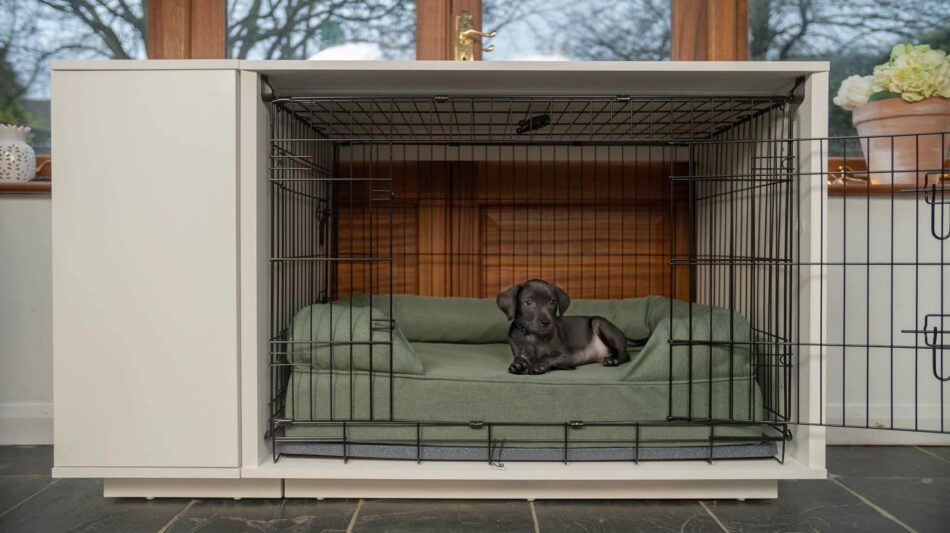

This entry was posted in Dogs
Whether you’re eagerly awaiting the arrival of a new puppy or opening your heart and home to a rescue dog, the decision to bring a canine companion into your life marks the beginning of an exciting journey. When adding another furry member to your family, you need to ensure you’re equipped with the right essentials to provide a comfortable and loving environment for your new best friend. In this blog, we’ll walk you through a comprehensive new dog checklist covering everything you’ll need to consider when welcoming a new canine companion into your life.
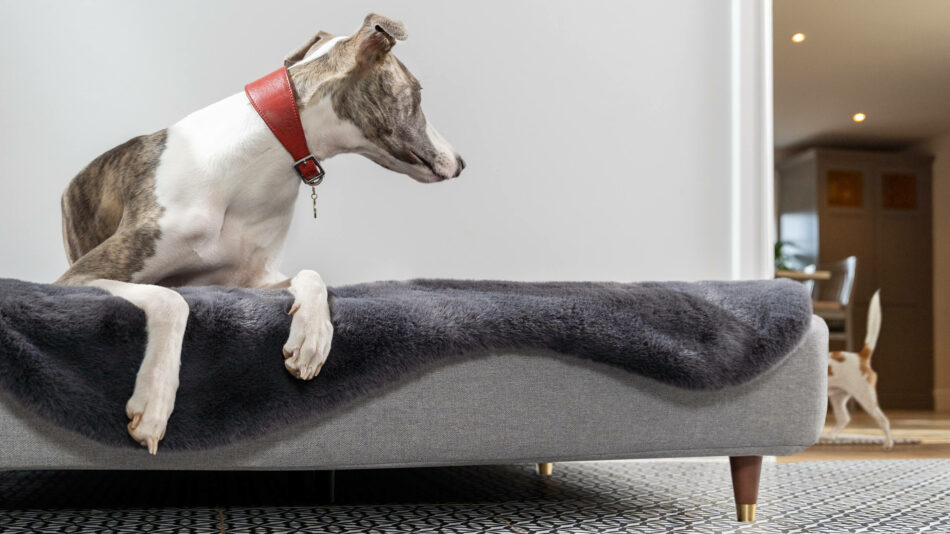
Dog beds
One of the first items to consider when welcoming a new furry friend into your home is a cozy spot for your dog to rest and relax. Enter the world of dog beds, where comfort meets functionality in a variety of shapes and sizes to suit every pup’s needs. Whether you opt for a plush cushion, an orthopedic mattress, or a durable outdoor bed, choosing a bed that suits your dog’s size, age, and sleeping habits is essential. Be sure to consider factors such as washability, durability, and support to ensure your pup gets a good night’s sleep.
Omlet’s Topology dog beds stand out for their customizable design, allowing you to create the perfect sleeping space tailored to your dog’s preferences. With interchangeable toppers of varying style and design, you can adjust the bed’s configuration to accommodate your dog’s sleeping habits. These beds not only provide orthopedic support for joint health but also boast durable and washable materials, ensuring long-lasting comfort for your canine companion.
Let’s not forget the comforting embrace of Omlet’s Bolster dog beds, providing a sense of security and support for dogs who love to snuggle up against the raised edges. Made from premium materials and available in a range of stylish colours, these beds add a touch of luxury to your dog’s sleeping quarters while promoting a sense of well-being and contentment.
Dog crates
Dog crates are an indispensable addition to any new dog checklist, offering numerous benefits that contribute to the well-being and training of your furry companion. Beyond being a safe and secure space for your dog to rest, crates serve as valuable tools for house training and behaviour management. By providing a designated “zen den” for your dog, you offer them a sanctuary where they can retreat when they need downtime or simply want to feel secure. This sense of ownership over their own space can help alleviate anxiety and stress, especially during times of transition or when faced with unfamiliar environments. Moreover, crates facilitate transportation, whether it’s a trip to the vet or a family vacation, ensuring your dog travels comfortably and securely while reducing the risk of escape or injury.
Investing in a quality dog crate is akin to providing your furry friend with their own personal haven within your home. When selecting a crate, consider factors such as size, material, and accessibility to ensure it meets your dog’s needs and complements your lifestyle. With proper introduction and positive reinforcement, your dog will come to view their crate as a safe haven rather than a confinement, fostering a sense of security and contentment. Ultimately, integrating a crate into your new dog’s routine not only aids in training and management but also strengthens the bond between you and your canine companion, laying the foundation for a harmonious and fulfilling relationship.
Dog leads/collars
When it comes to essentials for your new furry friend, dog leads and collars are at the top of the list. Think of them as the keys to unlocking adventures and ensuring safety during daily walks. A sturdy lead and well-fitted collar not only provide you with control and peace of mind but also give your dog the freedom to explore their surroundings safely.
But it’s not just about functionality; choosing the perfect lead and collar can also reflect your dog’s personality and style. Whether you opt for a vibrant patterned collar to showcase your pup’s playful side or a sleek, minimalist lead for a touch of sophistication, these accessories can add a dash of flair to your walks together. With the right lead and collar, you’re not just taking your dog for a walk—you’re making a fashion statement while strengthening your bond with your furry companion.
Dog bowls
When it comes to welcoming a new dog into your home, dog bowls are absolute essentials that should not be overlooked. These crucial items provide your dog access to fresh water and nutritious meals throughout the day. So investing in high-quality dog bowls not only ensures your dog’s basic needs are met but also promotes proper hydration and digestion, contributing to their overall well-being.
Whether you opt for stainless steel, ceramic, or melamine dog bowls, choose ones that are tailored to your dog’s size and eating habits in order to foster a positive dining experience for your canine companion. With sleek, modern designs and stylish shades, there’s a dog bowl to suit every taste and décor preference.
Dog accessories
When it comes to preparing for a new dog, accessories play a vital role in ensuring their comfort and well-being. Dog blankets are not just cosy additions to their sleeping area; they offer a sense of security and warmth, much like a comforting hug. Whether it’s a plush fleece blanket for snuggling on chilly nights or a waterproof option for outdoor adventures, having a few blankets on hand provides your furry friend with a familiar and inviting space to rest and relax. Plus, let’s be honest, who doesn’t love wrapping their pup up in a soft blanket for some extra cuddles?
Similarly, dog cooling mats are absolute game-changers, especially during the hot summer months. These innovative accessories offer relief from the sweltering heat, providing a cool surface for your dog to lounge on and escape the rising temperatures. Whether placed indoors or outdoors, cooling mats help prevent overheating and ensure your pup stays comfortable and refreshed, even on the hottest of days. So, don’t forget to add these essentials to your new dog checklist – because every pup deserves to be pampered with the best in comfort and relaxation.
Dog toys
Just like humans, dogs need outlets for their energy and natural instincts, and dog toys provide the perfect solution. From plush squeaky toys to durable chew bones and interactive puzzle feeders, the variety of toys available caters to different breeds, sizes, and play styles. Dog toys not only keep your dog occupied and entertained but also help prevent boredom and alleviate stress, especially during periods of alone time or when left at home.
Additionally, interactive dog toys that dispense treats or require problem-solving skills can challenge your dog’s cognitive abilities, keeping their mind sharp and engaged. By including a selection of toys in your dog’s environment, you’re not just providing entertainment – you’re promoting overall well-being and enriching their quality of life.
Furthermore, dog toys play a significant role in strengthening the bond between you and your furry friend. Engaging in playtime activities together fosters trust, communication, and companionship, creating lasting memories and deepening your connection. Whether it’s a game of fetch in the backyard, a tug-of-war session indoors, or a relaxing chew session on the couch, these shared experiences strengthen the bond between you and your dog, building a foundation of love and mutual understanding.
Omlet and your dog
As you prepare to welcome a new dog into your life, remember that each pup is unique, with their own set of needs and preferences. By equipping yourself with the right essentials and taking the time to understand your dog’s behaviour and personality, you’ll be well on your way to building a strong bond and creating lasting memories together. At Omlet, we believe in asking the right questions to understand how to invent products that enhance the lives of both pets and their parents. From innovative dog crates to cosy dog beds, we’re dedicated to making life better for pets and pet owners alike and bringing the adventures with your new furry friend one step closer.
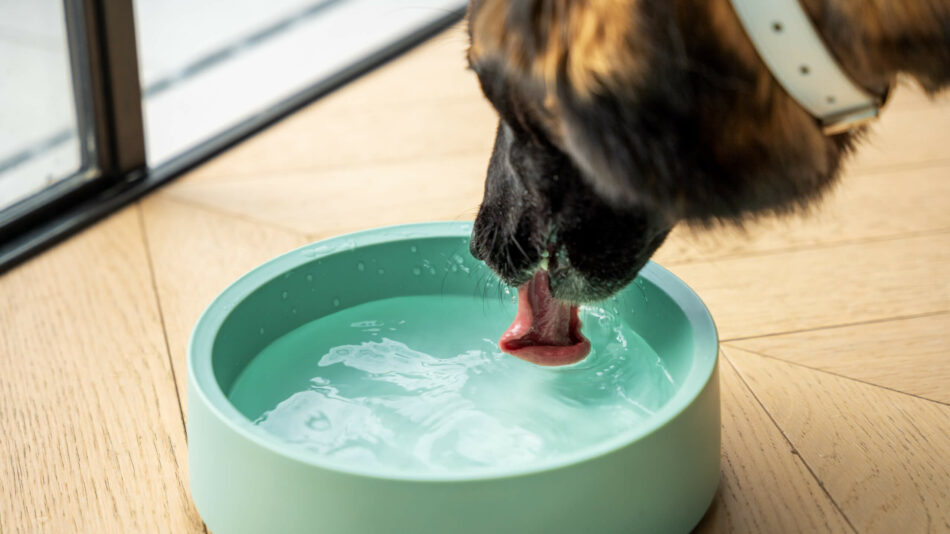

This entry was posted in Dogs
Welcoming a furry friend into your home is an exciting decision, but how do you know the right dog to bring that into your family? With countless breeds to choose from, finding the perfect match can seem daunting. However, understanding the different breed types and their characteristics can guide you towards a companion that complements your family dynamics as well as your lifestyle and preferences. From energetic outdoor adventurers to cuddly couch companions, there’s a dog breed suited for every household.

Hound breeds
Hound dogs are the quintessential embodiment of loyalty, charm, and an insatiable zest for adventure. With their characteristic droopy ears and soulful eyes, these four-legged friends bring a unique blend of affection and curiosity to any household lucky enough to welcome them in. Examples of dogs in this breed include the beagle, bloodhound, and greyhound. Renowned for their keen sense of smell and unwavering determination, hounds have historically been prized as hunting companions. However, their gentle demeanour and unwavering loyalty make them equally cherished as beloved family pets.
When considering adding a hound dog to your family, it’s important to understand their personality traits and the lifestyle they thrive in. These pups are known for their independent streaks, often following their noses wherever it leads them. This means they may not always be the most obedient of companions, but their playful antics and boundless enthusiasm more than make up for it. Hounds are social creatures who revel in the company of their human pack, making them ideal for families who enjoy spending time outdoors and engaging in activities that stimulate their curious minds.
Whether it’s a leisurely hike through the woods or a lively game of fetch in the backyard, hound dogs thrive in environments where they can explore and unleash their natural instincts. So, if your family is seeking a loyal and adventurous companion to join in your escapades and add a touch of excitement to your everyday life, a hound dog might just be the perfect fit for you.
Working breeds
Working dog breeds encompass a diverse group known for their intelligence, loyalty, and strong work ethic. From the energetic Australian Cattle Dog to the steadfast bernese mountain dog, each breed brings unique qualities shaped by their historical roles alongside humans. These breeds thrive on mental and physical stimulation, often requiring purposeful activities to channel their boundless energy. Families seeking a companion that doubles as a partner in adventure and exploration will find an ideal match within this dynamic group. Their unwavering dedication makes them invaluable additions to households willing to provide ample outlets for their natural instincts.
Understanding the nuances of working dog breeds is crucial when determining their compatibility with different family dynamics. For active households with an outdoor lifestyle, breeds like the anatolian shepherd dog or the Siberian Husky are well-suited companions, excelling in activities like hiking, running, or even dog sports. But before welcoming any working dog breed into your home, first assess your family’s lifestyle, commitment to training, and available space. Potential owners of this breed should also consider factors like grooming needs, shedding, and potential health concerns associated with these dogs to ensure a harmonious match for both family and furry friend.
Toy breeds
Toy dog breeds encompass a delightful array of pint-sized pooches, each packed with personality and charm. From the spunky chihuahua to the regal pomeranian, these compact canines offer big love in small packages. Their petite stature makes them perfect companions for various types of families, but understanding their unique traits is key to finding the best fit.
For families seeking cuddly companionship and low-maintenance care, toy breeds like the affectionate Cavalier King Charles Spaniel or the gentle Maltese might be ideal. These breeds thrive on human affection and are often content to curl up on the couch with their loved ones, making them perfect for families with children or seniors looking for devoted companionship.
Sporting breeds
If you have a bustling household that is filled with laughter, play, and endless adventures then you have the perfect setting for a sporting dog breed. These furry athletes are like the MVPs of the dog world, ready to join in on any family fun with their boundless energy and unwavering loyalty. Whether you’re a thrill-seeking clan that loves hiking through rugged trails or a laid-back crew content with leisurely strolls in the park, there’s a sporting dog breed tailor-made for your unique vibe.
The labrador retriever, otherwise known as the social butterfly of the group, is always up for a game of fetch or a dip in the nearest body of water. Their friendly demeanour and eagerness to please makes them the perfect companions for families who crave constant companionship and plenty of outdoor activities. Then there’s the adventurous Brittany, a pint-sized powerhouse bursting with enthusiasm and intelligence. So whether you’re a high-energy household or a laid-back bunch, there’s a sporting dog breed out there waiting to become your family’s four-legged best friend.
Terrier breeds
Terriers, with their spunky personalities and boundless energy, are a spirited bunch that brings a whole lot of character into any home. From the feisty Jack Russell Terrier to the tenacious Scottish Terrier, these small to medium sized powerhouses pack a punch of personality. Terriers are known for their intelligence, determination, and fearlessness, making them perfect companions for families who thrive on excitement and adventure. If you’re looking for a dog that’s always up for a challenge and eager to explore the world alongside you, a terrier might just be your perfect match.
When considering a terrier for your family, it’s essential to understand their unique traits and how they align with your lifestyle. Terriers are often best suited for active families who can keep up with their high energy levels and provide plenty of mental and physical stimulation. But their natural hunting instincts and strong prey drive mean they may not be the best fit for households with small pets like cats or rabbits. However, for families who enjoy outdoor activities, games, and interactive training sessions, terriers can be incredibly rewarding companions.

Herding breeds
From the iconic border collie to the spirited Australian Shepherd, the herding dog breeds excel at managing and controlling livestock with their innate herding instincts. Known for their intelligence, loyalty, and remarkable work ethic, these dogs thrive in environments where they have a job to do or tasks to accomplish.
But beyond their herding prowess, herding dogs make fantastic companions for families who appreciate their sharp minds and unwavering devotion. If you’re a family with an active lifestyle and enjoy engaging your furry friend in stimulating activities, a herding dog could be your perfect match. With the ability to adapt to various living situations, herding dogs can bring endless joy, companionship, and a touch of adventure to your home.
Non-sporting breeds
The non-sporting dog breed group is a colourful collection of canines with a wide range of personalities and temperaments. From the dignified bulldog to the lively poodle, each dog in this breed brings its own unique charm to the table. While they may not all share a common purpose like hunting or herding, non-sporting dogs make up for it with their diverse array of traits and adaptability.
For families seeking a four-legged friend that fits seamlessly into their lifestyle, understanding the personality traits of non-sporting breeds is key to finding the perfect match. Whether you’re a family that likes a cosy night in and leisurely strolls around the neighbourhood or are a household of many children that are actively on the go, you’re sure to find a non-sporting dog that will complement your clan. These dogs thrive on companionship and are content to snuggle up on the couch with their favourite humans.
Rescue dog vs. puppy: The debate
When considering adding any dog of any breed to your family, the decision between adopting a rescue dog or bringing home a puppy is typically the next significant consideration. Rescue dogs offer the opportunity to provide a loving home to a dog in need while puppies allow families to shape their companion’s upbringing from the beginning.
Pros of rescue dogs:
- Rescue dogs often come with established personalities and behaviours, making it easier to assess compatibility.
- Adopting a rescue dog gives them a second chance at a loving home, providing a rewarding experience for the entire family.
- Many rescue organizations provide support and resources to ensure a successful transition for both the dog and the family.
Cons of rescue dogs:
- Rescue dogs may come with unknown backgrounds or behavioural issues that require patience and training to address.
- It may take time for a rescue dog to adjust to their new environment and form bonds with their new family members.
- Certain rescue dogs may have medical or behavioural issues that require ongoing care and attention.
Pros of puppies:
- Bringing home a puppy allows families to shape their companion’s behaviour and training from a young age.
- Puppies provide an opportunity for families to bond and create lasting memories as they grow together.
- Puppies typically have fewer health and behavioural issues compared to some rescue dogs.
Cons of puppies:
- Raising a puppy requires time, patience, and commitment to proper training and socialization.
- Puppies go through various developmental stages, including teething and housebreaking, which can be challenging for first-time dog owners.
- The initial costs of vaccinations, spaying/neutering, and supplies can add up quickly.
Omlet and your dog
Choosing the right dog for your family is a significant decision that requires careful consideration of various factors, including breed characteristics, lifestyle, and preferences. At Omlet, we understand the importance of this decision and strive to create innovative pet products that enhance the bond between pets and their owners. With cosy dog beds, we’re here to support you on your journey to a fulfilling and enriching companionship with your dog and celebrate the wonder of your bond together.


This entry was posted in Dogs
Ah, the simple joy of watching our furry companions curl up into a cosy ball and drift off into dreamland. For dog lovers, witnessing our canine friends catch some z’s is a delightful spectacle that never fails to warm our hearts. But did you know that behind those adorable snoozing poses lie a plethora of fascinating facts about dogs and their sleeping habits? Prepare to be intrigued as we delve into 7 things you didn’t know about dogs and sleep.
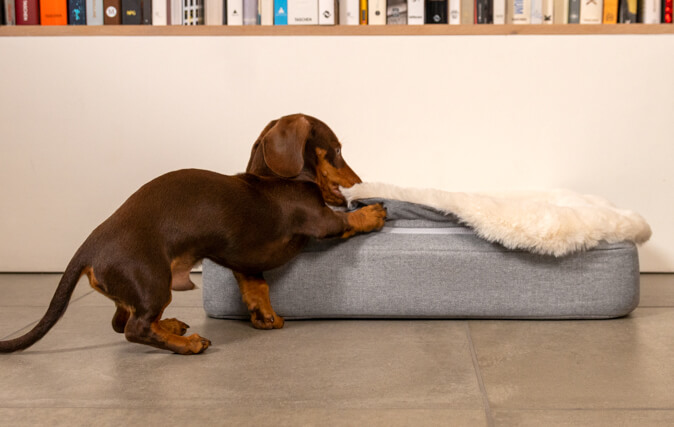
Dogs circle before bed:
Ever wonder why your dog makes a few rounds before finally settling down for the night? This seemingly quirky behaviour actually has deep-rooted evolutionary significance. In the wild, dogs would circle to create a comfortable sleeping spot and to ensure safety from predators. It’s a natural instinct, ingrained in their DNA, to create a spot that is comfy for sleep but away from danger.
Even though our domestic pups may not face the same threats, their innate behaviour remains a part of their makeup. You can cater to this ancestral need by making sure your dog has a comfortable and supportive dog bed that fits their size. Allowing your dog the opportunity to have a warm and cozy spot to sleep will ensure their primal and domestic needs are met.
Dogs do dream:
Have you ever noticed your dog twitching, whimpering, or even barking in their sleep, and wondered if they’re chasing all those squirrels they never quite catch in real life? Well the answer isn’t entirely clear cut.
Dogs do indeed dream; research suggests that dogs experience similar sleep patterns to humans, including the rapid eye movement (REM) stage where dreaming occurs. But while it’s confirmed that dogs do dream, the content of their dreams still remains a bit of a mystery.
Are they dreaming about playing with their toys, other dogs, or better yet, you? We may never know for sure. Our furry friends can’t spill the beans on their dreamland wonder but we like to think that their humans are never far from their subconscious adventures.
The meaning behind dog yawns:
You know how sometimes you just can’t help but let out a big yawn when you’re feeling sleepy or bored? Yawns are universally recognized as a sign of tiredness or boredom, but when it comes to dogs, there’s more to it than meets the eye. In humans, some yawning is a way of empathizing; we often yawn when others do, in a subconscious show of solidarity.
When dogs yawn, it can actually be a way for them to communicate with us and other dogs around them. It’s like their way of saying, “Hey, I’m feeling a bit stressed or anxious right now.” Just like humans, dogs can feel a range of emotions, and yawning is one of the ways they might express those feelings.
But dogs also yawn as a way to calm themselves down in tense situations. So if you notice your furry friend giving a big yawn during a training session or when meeting new people, it might not be because they’re bored or tired, but rather because they’re trying to soothe themselves. It’s their version of taking a deep breath to relax. So give your dog some space if you notice a big yawn and try to read their body language to see if they might need a little extra comfort or support.
Zoomies before z’s:
We’ve all witnessed the phenomenon of “zoomies”—those bursts of frenetic energy that seem to possess our dogs out of nowhere. Surprisingly, these spirited romps often occur just before bedtime. While it may seem counterintuitive, this behaviour is believed to be a natural way for dogs to release excess energy before settling down for the night.
In the wild, dogs would spend their days hunting, exploring, and playing, so they’d naturally be pretty active. As the sun starts to set and night falls, their instincts kick in, telling them it’s time to find a safe spot to rest and recharge for the next day’s adventures. So, those pre-sleep zoomies are basically their way of mimicking that wild behaviour, getting rid of any excess energy so they can sleep soundly through the night. It’s like their own little bedtime routine, complete with a sprint to the finish line before settling in for some well-deserved rest.
Paws up, eyes closed:
Ever notice how your furry friend sometimes snoozes with their paws flung up in the air like they just don’t care? It’s a common sight in the canine world, and there’s more to it than just striking a cute pose. Dogs often sleep with their paws in the air as a sign of relaxation and comfort. Just like we might sprawl out on the couch after a long day, our four-legged pals stretch out in all sorts of positions to unwind. With their paws up, they’re releasing tension in their muscles and letting their bodies sink into a state of blissful repose
But why exactly do they choose this particular position? When your dog plops down on their back with their paws in the air, they’re exposing their most vulnerable parts—like their belly—to the world. It might seem counterintuitive to us humans, but for dogs, it’s a sign of trust and security. By showing off their soft underbelly, they’re letting you know that they feel completely safe and at ease in their surroundings. It’s a testament to the bond between you and your furry companion.
Dogs have a third eyelid:
As dog owners, it’s natural for us humans to want to stare all day at our furry canine companions as they sleep. But sometimes, you may notice that one eye almost looks like it’s still open while the snores are still filling the room. Are they half awake? Nope. That’s just your dog’s third eyelid you’re seeing. Also known as the nictitating membrane, this translucent membrane serves as an extra layer of protection for a dog’s eyes. And it’s most commonly seen when they are in deep slumber.
While it may sound odd, this unique feature helps keep their eyes moist and shielded from debris. And it also acts as a trusty defender keeping your canine companion’s eyes squeaky clean. Think of it as a natural windshield wiper, sweeping away any gunk or goop that might try to cling onto those adorable puppy eyes. So, the next time you catch a glimpse of your dog’s third eyelid, remember, it’s just another fascinating aspect of their anatomy that makes them so wonderfully unique.
Dogs sleep for half their life:
It’s no secret that dogs love their beauty sleep, but just how much do they snooze? As it turns out, dogs spend approximately half of their lives sleeping. While the exact amount varies depending on factors like age and breed, it’s safe to say that our canine companions are true sleep enthusiasts. While your dog’s snooze sessions might seem excessive, they’ve actually got it all figured out.
While we humans often juggle hectic schedules and burn the candle at both ends, our four-legged companions show us the true meaning of balance. From chasing squirrels to playing fetch, dogs throw themselves into every activity with boundless enthusiasm and when it’s time to recharge, they do it. So make sure your furry friend has a comfy dog bed to catch all their z’s and maybe try relaxing with them the next time they have a nap.
Omlet and your dog
Understanding the intricacies of dogs and their sleep habits is just one way we can deepen our connection with our beloved pets. At Omlet, we recognize the importance of catering to every aspect of our dogs’ well-being, from their sleep to their playtime and beyond. That’s why we’re dedicated to crafting innovative products like customisable dog beds and meticulously engineered dog dens that enhance the lives of both dogs and their owners, ensuring they can spend more quality time resting by your side. Because when it comes to our furry friends, every moment shared, waking or sleeping, is truly precious.


This entry was posted in Dogs
Keeping your furry friend active is essential for their physical health and mental well-being. While walks around the block are great, sometimes you and your dog need a little variety in your exercise routine. That’s where these 7 different and fun exercise ideas for your dog come in handy. Whether rain or shine, indoor or outdoor, there’s something here for every pup, and human, to enjoy.
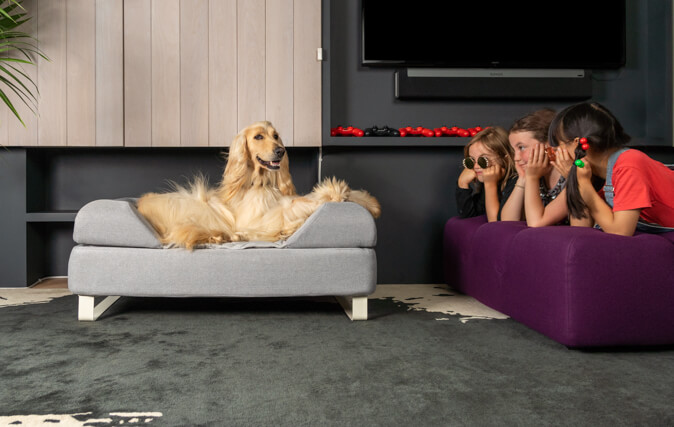
Outdoor adventure walks
Take your routine walks around the neighbourhood up a notch by seeking out new adventure walks. Yes, dogs like routine, but they also like new smells and experiences too. So instead of sticking to the same old path, try exploring new trails, parks, or nature reserves. An entire oasis of new sights and smells is ready for you and your dog to discover when you venture out into the wild.
Setting it up: Start by researching dog-friendly trails or parks in your area. You likely won’t have to drive too far to find some pretty cool new trails or parks to explore. Because you’ll be checking out new surroundings, be sure your dog is wearing their favourite dog collar and lead with proper identification. Bring water and snacks for both you and your pup and a dog blanket or dog bed so they can rest on the way home.
Why it’s good: Outdoor adventure walks provide loads of mental stimulation for your dog and allow them to engage with their natural instincts. Exploring new environments keeps a dog’s mind sharp and promotes overall happiness.
Fetch and retrieval games
Fetch is a classic game that never gets old and is a guaranteed way to exercise your dog. And the best part is it doesn’t take a lot of work to play this fun game together. Simply find an open space, like a backyard or a dog park, and let your dog chase after a ball or a frisbee. Retrieval games are not only fun but also great for improving your dog’s agility and coordination.
Setting it up: Choose a safe area that is free from obstacles or hazards. Be sure it’s a space that allows dogs to be off leash and is safe for them to be running free. Start with short throws of a ball, frisbee, or even their favourite dog toy and gradually increase the distance as your dog gets more comfortable. And don’t forget to bring a dog bowl with water as your dog will need to rehydrate often.
Why it’s good: Fetch and retrieval games are a great form of dog exercise as they provide excellent cardiovascular health for your dog while also strengthening their muscles. But perhaps the best part of a game of fetch is the bonding experience between you and your pup, which is priceless.
Outdoor agility course
Have you ever watched dog agility competitions on TV and wondered if your dog could be an obstacle pro as well? Only way to know is to try it. Agility courses are a fantastic way to challenge your dog both mentally and physically. And they can be as easy as setting up tunnels, jumps, and weaving poles in your backyard. You and your dog will love the fun that comes with an outdoor agility course and how rewarding it is for dogs of all ages and breeds.
Setting it up: When it comes to agility courses you don’t have to go straight out and purchase expensive agility equipment. You can use items around your house that are suitable for your dog’s size and skill level. Cardboard boxes, laundry baskets, and even your kid’s orange play cones are all perfect items that can help construct a beginner agility course. Start with basic obstacles and gradually introduce more advanced challenges as your dog gets the hang of it.
Why it’s good: Agility training is an excellent exercise for dogs as it improves their balance, coordination, and problem-solving skills. It also builds their confidence and strengthens the bond between the two of you.
Swimming sessions
If your dog loves the water, then swimming is an excellent full-body workout to incorporate into their exercise routine. But how do you know if your dog likes to swim? Start by finding a dog-friendly beach, lake, or pool where your pup can splash around safely to test the waters and see if they like it. Even if your dog doesn’t go all the way in for a full body dip, the act of running along the water will provide enough exercise. Swimming is especially beneficial for older dogs or those with joint issues.
Setting it up: If your dog has never swam before or if you are not sure they know how to swim, start by choosing a calm, shallow body of water to start. This will allow your dog to explore the possibility of swimming without too much commitment. And always be sure to have the right products when going for a doggie dip – consider a canine life jacket for added safety, a properly tagged dog collar, an old towel to rub them down and some dog treats to enjoy after a good splash will all make this experience more enjoyable.
Why it’s good: Swimming is a low-impact exercise that’s gentle on your dog’s joints. Your dog will receive a thorough workout without putting stress on their bones. But the best part? Swimming is a great way to beat the heat during hot summer months.
Indoor treat hunt
When the weather outside is too cold or rainy to explore an outdoor exercise, try setting up some workout routines inside. Indoor treat hunts are a fun way to keep your dog mentally stimulated while also getting them to move their bodies. And it can be as easy as hiding treats around the house and letting your dog use their nose to sniff them out.
Setting it up: The key to making an indoor treat hunt fun for your dog is to choose a variety of different hiding spots. This is your time to get creative. While your dog’s in another room, quietly hide dog treats under furniture, behind doors, or even inside their dog crate house. As your dog becomes efficient at finding the treats in the easy hiding spots, gradually increase the difficulty by choosing more challenging spots.
Why it’s good: Indoor treat hunts are a great way to engage your dog’s sense of smell and provide mental stimulation at the same time. Spending time “hunting” and sniffing will also help to prevent your dog’s boredom and destructive behavior.
Interactive toys and games
If there’s one exercise that is guaranteed to tire your dog out regardless of the weather, it’s playtime with you and their favourite interactive dog toys. Not only do toys and games keep your dog engaged, exercised, and entertained, they’re a great way to keep your furry friend challenged. Keep a variety of different toys and games such as puzzle toys, treat-dispensing balls, or interactive play mats so that your dog’s problem-solving skills can be challenged and elevated.
Setting it up: Too much of a good thing can often lead to overwhelm and that is true when it comes to dogs and toys. So set aside time each day to bring out one or two toys to play with your pup. If it’s a new toy, introduce it to your dog by itself so they can fully immerse themselves in the nuances of the new object. Every other week, try rotating the toys regularly to keep your dog’s interest piqued and their excitement engaged.
Why it’s good: Interactive dog toys and games are the perfect exercise tool for dogs as they provide mental stimulation and prevent boredom. If you live somewhere where the weather prohibits frequent outdoor play, dog toys are an essential in maintaining your dog’s physical health and mental well-being.
Indoor obstacle course
Who said obstacle courses are only for the great outdoors? When the weather isn’t cooperating for outdoor play, take the fun inside and create a DIY obstacle course. Again, no need to purchase any expensive agility equipment – simply use household items like chairs, cushions, and cardboard boxes to create the ultimate indoor dog adventure. Just be sure to designate a space in your home where your dog can navigate through tunnels, jump over hurdles, and weave between obstacles without hurting themselves or your furnishings.
Setting it up: Start by clearing a space in your home where you can set up the obstacle course safely. Choose a room that is big enough for your dog to navigate based on their size and remove any pieces of furniture or items that could cause them harm or get damaged in the process. When choosing items for the obstacle course, pick ones that are stable and won’t topple over easily – this is all about having fun, so make sure not to use anything that could cause injury or get broken.
Why it’s good: Indoor obstacle courses provide incredible physical exercise and increased mental stimulation for your dog as well. The repetitive sequencing of traversing the course reinforces obedience and agility skills, which are both excellent for your dog’s body and mind.
Omlet and your dog
No matter the weather, keeping your dog active and engaged is crucial for their overall well-being. Whether you’re exploring the great outdoors or getting creative with indoor activities, there’s no shortage of ways to keep your pup exercised and entertained. At Omlet, we understand the importance of movement for all pets, and also for the vital sleep they require afterwards which is why we offer a wide range of dog beds designed to give your dog the best rest they can get. So get out there, have fun, and start exercising with your dog.
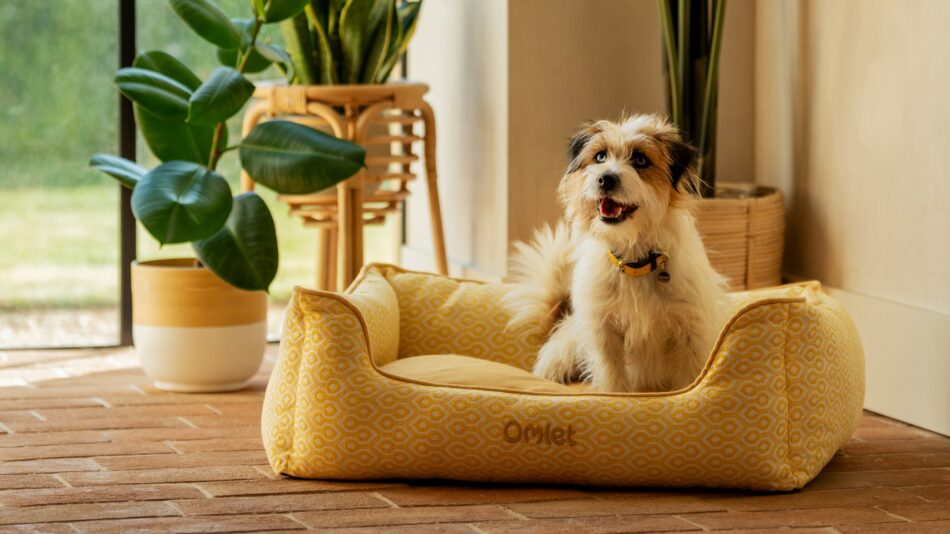

This entry was posted in Dogs
As pet owners, we cherish the moments when our furry companions snuggle up for a peaceful slumber. Yet, what happens when our beloved canine companions toss and turn, unable to find the rest they need? Understanding what is affecting your dog’s sleep is crucial for ensuring their well-being and happiness. Let’s delve into the intricacies of what might be keeping our pups up at night and explore effective solutions to promote their quality rest.
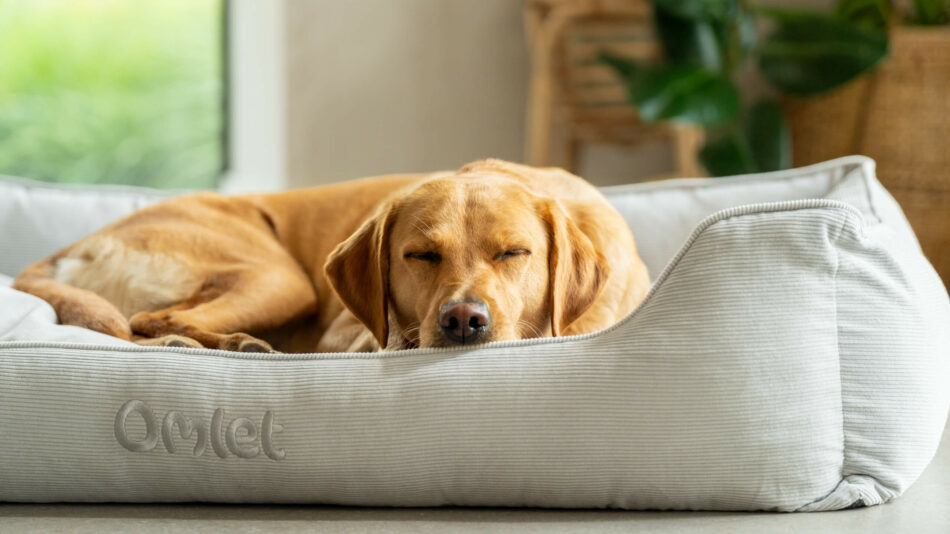
What could be affecting my dog’s sleep?
Ever wondered why your furry friend seems restless at bedtime? It could be anything from an unbalanced diet to a change in routine that throws off their sleep cycle and leaves them in need of some serious R&R. Here’s a look at some of the common factors that could be affecting your dog’s sleep.
Lack of exercise
Just like humans, dogs require regular physical activity to tire their bodies and minds. A lack of exercise can lead to pent-up energy, causing restlessness and difficulty in settling down for sleep. Daily walks, interactive play sessions, or engaging in stimulating activities tailored to your dog’s breed and age can significantly contribute to a more restful night’s sleep.
So grab your dog’s favourite lead and collar and make walking around the neighborhood a daily activity. Or make a game out of hide-and-go-seek their favorite dog toy. As soon as you notice your dog feeling unsettled in their nighttime routine, the fix could be as easy as incorporating more fido fitness.
Underlying health issues
If adding more exercise to your dog’s routine isn’t working, or their age has limited their activity, it may be time to look a little deeper into what might be impacting their sleepless nights. Undiagnosed health problems could be silently disrupting your dog’s sleep patterns.
Conditions such as arthritis, dental pain, or even anxiety disorders can interfere with a dog’s ability to find comfort and relaxation. So it’s important to stay on top of regular veterinary check-ups and pay prompt attention to any concerning symptoms. A healthy dog is a happy dog and happy dogs are more likely to get quality sleep.
Poor diet
Did you know nutrition plays a pivotal role in your dog’s overall well-being? That includes their sleep quality, too. Feeding your furry friend a balanced diet that is appropriate for their age, size, and activity level is crucial not only for their health, but their sleep quality. So if you notice your dog awake more during nighttime hours, it could be linked to diet.
Is someone in the house feeding from under the table when they aren’t supposed to? Is your dog eating too much or too little? Poor diet choices or food allergies can lead to gastrointestinal discomfort which could be keeping your dog awake. Be sure to consult with your veterinarian if you notice sleep issues that you think could be related to food, so you can be sure of feeding the most suitable diet for your dog.
Environmental factors
The environment in which your dog sleeps can significantly influence their ability to rest peacefully. Factors such as excessive noise, uncomfortable bedding, or extreme temperatures are all factors that can disrupt their sleep cycle. Creating a quiet, comfortable, and safe sleeping space for your dog that is away from disturbances promotes better sleep by creating a space dedicated to their relaxation.
Find a dog bed that suits your dog’s sleep preferences. The Topology dog bed designed by Omlet is an excellent choice as it allows you to choose from a variety of Toppers to find textures your dog likes best. You’ll find it hard to pick a favorite, as they’re all designed to zip on and off easily and go straight in the washing machine. Adding some dog feet to the bottom raises the bed off the ground, promoting better hygiene and air flow. To help nervous dogs feel more secure, you can also add a dog crate nook so your pup has a secure space to retreat to when they need a solid snooze.
The Omlet Bolster bed is another great option for promoting restful sleep. A memory foam mattress combined with a full body snuggling cushion, angled to comfortably support their head as they snooze, this is a bed built to compete with the couch.
Change in routine
Dogs love and depend on routine. Disruptions to their daily schedule can cause stress and anxiety which, in turn, can lead to sleep disturbances. So if you’ve noticed your dog’s sleep patterns changing or disruptions in their normal cycles, check if any of these factors are new:
Any one of these factors can cause your dog stress, which could ultimately impact their sleep. So if you do have any upcoming or new changes in your house, do your best to maintain consistency in their daily routine and gradually introduce the changes where possible, so you can help minimize stress and promote better sleep habits for your furry companion.
Ways to prevent or help
When it comes to addressing your dog’s sleep issues it’s best to take a multifaceted approach that is tailored to their specific needs. Use the list above as a guideline to ensure all needs are being met: is your dog getting regular exercise, are they maintaining a balanced diet, and do they have a peaceful sleeping environment? Once you have taken a proactive look at all these factors, there are some additional things you can do to help ensure your dog’s healthy sleep habits.
Try incorporating calming routines before bedtime, such as a gentle massage or soothing music. This can help relax your furry friend and prepare them for a restful night’s sleep – plus the bonding time together is an added bonus. And whenever in doubt, seek guidance from a veterinarian or animal behaviourist as they can provide valuable insights and personalized strategies to address your dog’s specific sleep-related concerns effectively.
Omlet and your dog
At Omlet, we understand the importance of catering to the diverse sleep patterns and needs of all dogs. That’s why we design beds to suit the ergonomics of dogs’ bodies and with durable, upholstery grade fabrics tested to withstand their needs to stretch, turn and roll. All our products are engineered with your pet’s comfort and well-being in mind, offering a range of innovative solutions that will give them the rest they deserve. From cosy dog beds to comforting zen doggie dens, we strive to enhance the sleep experience for all dogs, helping them wake up refreshed and ready for another day of adventures by your side.
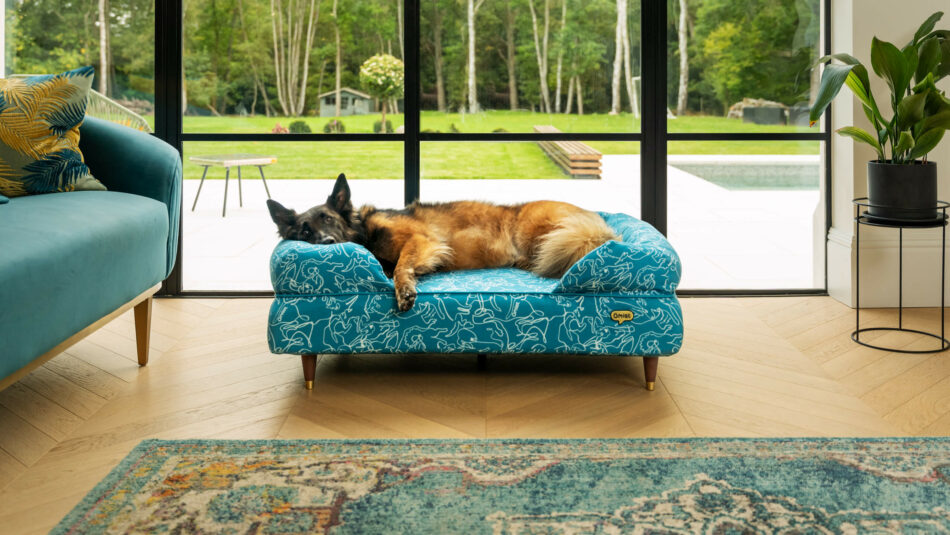

This entry was posted in Dogs

If there’s one thing we can all agree on, it’s that our furry friends bring boundless energy and infectious enthusiasm into our lives. And as responsible pet owners, we want to ensure our dogs live their best lives, filled with vitality and joy. But how do we determine the right amount of exercise for our canine companions? In this comprehensive blog, we’ll discuss everything from the importance of regular walks to the connection between exercise and sleep all to better understand how much you should be working out with fido.
Understanding your dog’s exercise needs
Dogs, like humans, require different levels of exercise depending on various factors such as age, breed, size, and health condition. Here’s a breakdown:
Puppyhood:
Just like kids, puppies need their daily dose of play and activity to channel their boundless energy positively, prevent boredom, and foster good behaviour habits. Regular exercise is crucial for puppies as it promotes healthy growth and development, strengthens muscles, and improves cardiovascular health, setting a foundation for a long and happy life.
Aim for around 5 minutes of exercise per month of age, up to twice a day, for puppies. This helps prevent overexertion and joint stress while still promoting healthy growth and development. Puppies need a balance between activity and rest to thrive, so tune in to their cues and adjust exercise accordingly.
Adult:
Whether it’s a brisk walk, a game of fetch, or a romp at the dog park, keeping our canine friends active not only enhances their physical fitness but also strengthens the bond between pet and owner. Regular exercise is crucial for adult dogs to maintain optimal health and well-being, just like it is for us humans.
Adult dogs generally require about 30 minutes to 2 hours of exercise per day, depending on factors like breed, age, and health status. Regular exercise keeps them mentally stimulated, maintains a healthy weight, strengthens muscles, and promotes overall well-being. A well-balanced exercise routine will make your adult dog feel well for longer.
Senior:
Our furry seniors need their daily dose of exercise to keep their tails wagging and their joints moving smoothly. Regular exercise helps senior dogs maintain a healthy weight, boosts their mental sharpness, and keeps their spirits high, ensuring they can continue enjoying their golden years to the fullest.
Senior dogs typically benefit from around 30 minutes to 1 hour of moderate exercise per day, tailored to their individual needs and health status. This amount helps maintain joint flexibility, muscle strength, and mental stimulation, promoting overall well-being and a longer, happier life.
Size and breed:
Tailoring exercise routines to suit a dog’s size and breed is crucial for their overall well-being. For instance, energetic breeds like border collies require vigorous daily activities such as long walks or engaging in agility training to stimulate their minds and bodies effectively. Conversely, smaller breeds like chihuahuas may not need as much physical exertion but still benefit greatly from short, frequent walks to maintain a healthy weight and prevent boredom-induced behaviours like excessive barking or chewing.
But how often should I walk my dog? That’s where understanding your pup’s specific breed and size matters. Larger, high-energy breeds like labrador retrievers may require at least an hour of vigorous activity daily to keep them happy and healthy, while smaller breeds like pugs may thrive with shorter, gentler walks or indoor play sessions to prevent overexertion and joint issues.
Ideas for exercise routines
Mixing up your dog’s exercise routine keeps things exciting and helps target different muscle groups. So tailor the exercise routine to your dog’s preferences and abilities, ensuring a fun and engaging experience for both of you. Here are a few ideas to consider:
Walks or jogging: While walking your dog might seem like the obvious choice for exercise, making it a habitual routine is what matters. So make it fun – get a dog collar and leash that fits your dog’s personality, lace up your shoes and head out together to walk or jog around the block. You can thank your dog for giving you a reason to stay healthy too.
Explore new places: Ready to take your dog walks to the next level? Spice up your exercise routine by exploring new trails, beaches, or even dog-friendly hiking spots. Let your pup sniff and discover the great outdoors while you both soak in some fresh air and scenery. Just be sure to bring a comfy, easy-to-travel dog bed so they have somewhere to rest on the way home.
Swimming sessions: If your pup is a water lover, like an Irish Setter or otterhound, consider swimming sessions as a great way to exercise. Whether it’s a dip in the backyard pool or a visit to a dog-friendly beach, swimming provides a low-impact workout that’s easy on the joints and a whole lot of fun for everyone.
Agility classes: If you like adventure and think your dog does too, sign up for agility classes together. Not only does it provide physical exercise, but it also stimulates your dog’s mind as they navigate through obstacles like tunnels, jumps, and weave poles. Plus, it’s a fantastic way to bond and boost their confidence.
Fetch and beyond: Engage your dog’s natural instincts with interactive games like fetch, hide-and-seek, or tug-of-war. Grab some dog toys and create a play session in the comfort of your own home to get fido moving. These games not only keep them physically active but also mentally stimulated, satisfying their need for both exercise and mental enrichment.
Doggie playdates: Have you ever seen kids on a playground? They’re running around, engaging in fun and moving their bodies. Well, the same thing happens when dogs get together. Arrange playdates with other friendly dogs to let them burn off energy while socializing. Whether it’s at a local dog park or a friend’s backyard, watching them zoom around with their furry pals is guaranteed to bring smiles, and exercise, all around.
Impact of exercise on sleep
Regular exercise isn’t just about keeping your furry friend fit; it also plays a crucial role in ensuring they get a good night’s sleep. Just like us humans, dogs reap numerous benefits from staying active during the day. When your pup gets their daily dose of physical activity, whether it’s a brisk walk, a game of fetch, or an agility session, it helps to tire them out both mentally and physically. This exhaustion isn’t a bad thing—it’s the key to unlocking deep, restorative sleep.
You’ve probably noticed how your dog flops down contentedly after a day of play, snoozing soundly without a care in the world. That’s because exercise helps regulate their internal clock and promotes relaxation, paving the way for a peaceful slumber. Plus, a tired dog is less likely to engage in nighttime shenanigans like excessive barking or restless pacing. So, by making sure your furry companion gets enough exercise, you’re not only enhancing their physical health but also setting them up for sweet dreams and blissful nights of sleep.
Omlet and your dog
At Omlet, we understand the importance of keeping your pets happy and healthy. That’s why we offer a range of innovative pet products designed to enhance your dog’s well-being. From interactive dog toys to cozy, easy-to-clean dog beds, our products are crafted with your pet’s comfort and happiness in mind. We didn’t invent dog products – we invented designs to make dog products better so you and your dog can spend more time together being happy and healthy.
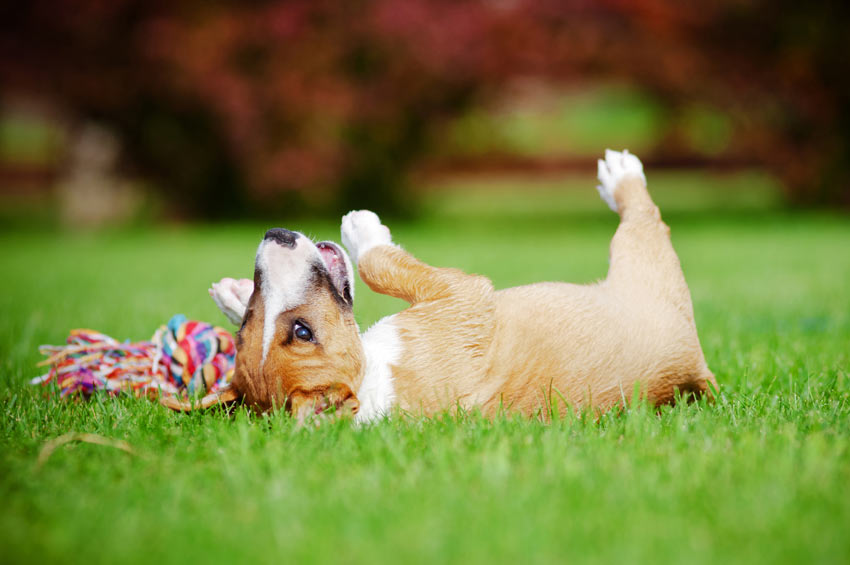
This entry was posted in Dogs

We’ve all heard about sleep schedules for babies and the importance of routine and adequate rest for their growth and development. But what about our furry companions? How much sleep should your dog be getting? As it turns out, just like humans, dogs require a significant amount of sleep to stay healthy and happy throughout their lives. Understanding their sleep needs can ensure we provide them with the rest they require to thrive.
Puppyhood to Senior sleep
Much like humans, the sleep needs of dogs evolve as they age. Puppies, with their boundless energy, may seem like they’re always on the go. However, puppies actually need (and usually get) more sleep than adult dogs. A typical sleep schedule for a young puppy can be anywhere from 18 to 20 hours a day. Because, just like babies, puppies need sleep in order for their bodies to grow.
But as your bundle of fur grows into adulthood, their sleep gradually decreases. Depending on dog breed and size, most adult age dogs will only require about 12 to 14 hours of sleep a day. Senior dogs, on the other hand, will start to log more sleep hours again, often clocking in around 14 to 16 hours per day. Understanding these sleep changes can help you tailor your dog’s specific environment to support their rest.
Why dogs need adequate sleep
Just like humans, dogs require plenty of quality shut-eye to maintain their health and happiness. Imagine your dog bounding through the park, chasing after balls, and eagerly greeting every passerby. Now, picture them doing all that on a measly few hours of sleep. It’s just not feasible. Here’s why our furry companions need their beauty rest:
- Physical recovery: Dogs need sleep to repair and rejuvenate their bodies after a day of activity. It’s during sleep that their muscles recover and grow, ensuring they stay fit and agile.
- Mental well-being: Dogs process a lot of information throughout the day, from learning new commands to deciphering the world around them. Adequate sleep is crucial for consolidating memories and maintaining cognitive function.
- Emotional stability: Have you ever noticed how cranky you feel after a sleepless night? Dogs are no different. Sufficient sleep helps regulate their emotions, keeping them calm and less prone to behavioral issues.
- Immune system support: Sleep is essential for a strong immune system. Dogs need adequate rest to fend off illnesses and stay healthy, just like humans.
So, the next time you catch your canine companion dozing off, rest assured they’re simply taking care of themselves.
The right dog bed makes a difference
Do you think you could get a good night’s sleep on just any mattress? Then your dog won’t either. Providing your dog with the right bed isn’t just about comfort; it’s about their overall relaxation and well-being. A comfortable dog bed is essential in helping your dog unwind, feel safe, and alleviate joint pain, especially for older or larger dogs.
Elevate their sleep: The right dog bed can truly transform your pup’s snooze game. With the Topology dog bed designed by Omlet, it’s not just a surface to crash on. This truly customizable and machine washable dog bed features a raised foot design that improves airflow, ensuring better air quality and comfort for your furry friend.
Surround them in comfort: Imagine a bed that wraps your dog in complete coziness, like a warm hug. That’s the magic of the Bolster dog bed designed by Omlet. With its memory foam backing, it’s like giving your pup their own miniature couch, offering unparalleled support and relaxation.
Ideal placement for dog beds
Where you place your dog’s bed can significantly impact their ability to relax and rest. Always opt for quiet, tranquil areas that are away from high-traffic areas and noise. Consider placing their bed in a spot where they can still feel connected to the family without being disturbed.
Additionally, keeping their bed clean is essential. Washable dog beds, like the Topology Dog Bed, make it easy to maintain a hygienic sleeping environment, promoting better sleep and overall health for your furry friend.
Better sleep = better health
Just like humans, better sleep translates to better health for dogs. A well-rested dog is more energetic, responsive, and engaged during walks and training sessions. And when your dog feels well rested and full of energy, you can’t help but reciprocate, further fostering a stronger connection and mutual understanding with each other. By prioritizing their sleep needs, you’re investing in their overall health and happiness.
Omlet and your dog
As pet owners, it’s our responsibility to ensure our furry companions receive the care and attention they need to thrive. Understanding their sleep requirements and providing them with the right environment, including a comfortable dog bed, plays a crucial role in their well-being. Omlet understands these needs and strives to innovate products like our designer dog beds and plush dog blankets that cater to every pet’s needs, ensuring they lead happy, healthy lives. So, next time you tuck your dog into bed, remember the importance of quality sleep for their vitality and longevity.


This entry was posted in Dogs

Have you ever watched your furry friend drift off into a deep slumber, legs twitching and softly whimpering, and wondered: do dogs dream? It’s a question that has intrigued pet owners for centuries, sparking curiosity about the inner workings of our canine companions’ minds. Let’s delve into the fascinating world of dog dreams and uncover the truths behind those mysterious nighttime adventures.
The science of dog dreams
Even though our dogs can’t awaken and tell us all about their dreams, scientists have long studied the sleep patterns of dogs to understand if they experience dreams similar to humans. Research indicates that dogs undergo similar sleep cycles to humans, including stages of deep sleep and REM (rapid eye movement) sleep, which is associated with dreaming.
During REM sleep, brain activity increases, resembling that of a waking state, suggesting that dogs in fact do experience dreams. But, our canine companions only experience REM sleep in 45 minute cycles on average. And depending on your dog’s breed and size, their dreams can last anywhere from 1 minute to 10 minutes.
While scientific evidence strongly suggests that dogs do dream, the specifics of their dream experiences remain elusive. Just like humans, dogs process their daily experiences and memories during sleep, leading to vivid dreamscapes that may involve familiar places, activities, or interactions. So the next time you see your furry friend twitching their legs in their sleep, they may just be dreaming about the game of catch you played with them earlier.
What do dogs dream about?
While dogs and humans share similarities in their dreaming experiences, there are also notable differences. Dogs’ dreams may be more heavily influenced by sensory stimuli and instinctual behaviours, reflecting their unique perspective on the world. Additionally, the duration and frequency of dreaming episodes vary among individual dogs, adding further complexity to the comparison.
Although we can’t peer into a dog’s subconscious, behavioural observations provide clues about the content of their dreams. Dogs often exhibit movements and vocalizations during sleep that mimic behaviours seen while awake, hinting that they may be reenacting past experiences or engaging in imaginary scenarios.
As cherished members of our families, it’s natural to wonder if our dogs dream about us. While there’s no definitive answer, studies suggest that dogs likely incorporate familiar faces and interactions into their dream narratives. So yes, it’s entirely possible that your dog dreams of bounding through fields with you or receiving belly rubs on lazy afternoons.
Dreamiest dog sleep solutions
When it comes to ensuring our furry friends get the dreamiest sleep possible, Omlet has you covered with our innovative dog bed solutions. We know sleep is important to dogs – like, up to 18 hours a day (or more) important. So we set out to ask the right questions to invent better ways to care for our beloved pets. Providing your dog with the perfect bed is key to their well-being and their dreams.
For the snugglers out there, the Omlet dog bed is like a cozy cocoon, offering a warm and secure haven for those who love to curl up tight. The Topology dog bed is ideal for leg splayers, providing ample space and support for dogs who sprawl out in all directions. Omlet dog beds are a versatile option perfect for on-the-go naps or as a comfy spot in any room of the house. With Omlet, you can rest assured that your furry friend will be dreaming in style and comfort, no matter their sleep habits.
Omlet and your dog
As you watch your beloved pup peacefully snooze, it’s fascinating to consider the vivid dreams they might be experiencing. Understanding this aspect of their lives is just one more way to deepen the bond between you and your furry friend. At Omlet, we’re passionate about enhancing the lives of pets and their owners alike. That’s why we create a range of products that cater to every aspect of your dog’s needs and desires, from luxurious dog beds for the coziest dreams to stylish designer dog collars for those daytime adventures. Because when it comes to your canine companion, only the best will do.
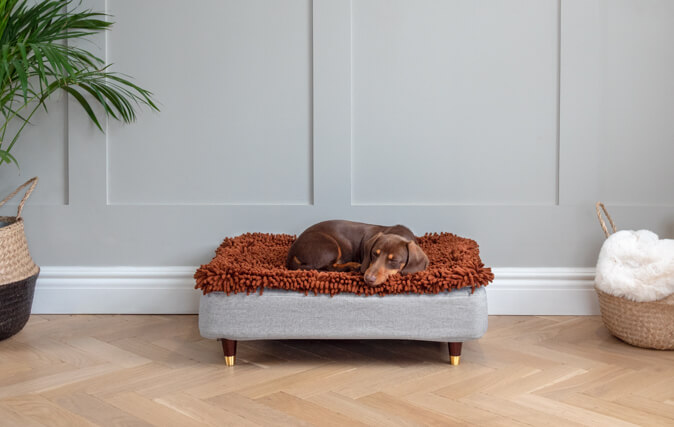

This entry was posted in Dogs





































